CV vs Resume - 5+ Key Differences in 2024 [w/ Examples]

You’ve probably heard the term “CV” more than once. Sometimes, it’s used as a synonym for a resume, but other times you’ve wondered if it means something completely different.
So, which one is it? What is a Curriculum Vitae, anyway? Is it any different from a resume?
You’re confused, and we don’t blame you.
That’s why this article is here to answer all these questions, and more!
We’re going to cover:

What Is a CV?
What is a resume.
- What Are the Differences Between Them?
Let’s dive in.

A CV is a document that summarizes your work experience, educational background, skills, and relevant achievements. It’s typically used when applying for jobs, college, or any other positions that require a structured overview of your professional profile.
The term CV itself is an abbreviation of the Latin Curriculum Vitae , which translates to “the course of your life.”
But the details behind what a CV actually is depend on where you are.
In most parts of the world, such as Europe, Asia, Australia, and even parts of Canada , a CV is identical to a resume, and the two words are used interchangeably.
Typically, a European CV is anywhere between one and two pages long . That said, we recommend you stick to a one-page CV unless you have a lot of experience, in which case a two-page CV is fine.
So, if you’re applying for a job in the United Kingdom and they request that you send in your CV, they’re basically asking that you submit a resume.

Looking for a job? Follow our detailed guide to learn how to write a CV !
What Is an American CV?
Now, if you’re applying for a job in North America, it’s a whole other story.
In the United States, a CV is a lot more detailed than a resume.
American CVs are meant to reflect all your experience so far. That means you need to include every job you’ve had, all levels of education, any publications, any projects, and other professional experiences or achievements.
Every time you accomplish something new, either professionally or academically, you should update your CV. That means that whenever you get a new job, publish a new paper, obtain a certificate, or earn an academic title, it goes on your CV.
In the US, though, a CV is only required when you’re applying for an academic or research position , which is why it can also be referred to as an academic CV.
And unlike a US resume , a CV can be up to a dozen pages long. The length of your CV depends entirely on how much experience you have.
What Should a CV Include?
Generally, these sections are must-haves for any CV :
- Contact Information
- CV Personal Statement
- Work Experience
- Educational History
- Skills and Expertise
Optionally, if you have leftover space, you can also include:
- Volunteer Experience
- Certificates
- Internships
- Publications
- Hobbies and Interests
Now, when you’re making an academic CV , things are a bit different.
Academic CVs follow a specific structure and can include over 15 different sections, in this order:
- Personal Profile or Research Objective
- Professional Appointments
- Grants and Fellowships
- Awards and Honors
- Conferences and Talks
- Teaching Experience
- Research Experience
- Other Activities
Not sure how to format your CV ? Read this article to find out!
Executive CV Example
Take a look at a two-page CV for an experienced professional:

Academic CV Example
Check out this great academic CV made with our very own CV builder :

A resume is a short, straight-to-the-point document created for the purpose of applying to a specific job.
Unlike the CV, you should try to keep a resume as short as possible.
In 99% of cases, you want to keep your resume to one page .
However, if you have more than 15 years of experience or if you really think that some extra information will add value to your application, you can make it, at most, two pages long.
When writing a resume , you should only mention aspects of your work experience and skills that are directly relevant to the exact job you’re applying for.
What this means is that if you’re applying for two different jobs, you need to create two separate resumes for them.
A well-written resume highlights your most impressive achievements and showcases how your different skills can be useful for the position you are applying to.
Usually, you would submit your resume alongside a cover letter , which lets you further explain why you’re applying and what makes you the right candidate for the job. Knowing how to write a great cover letter can complement your resume and show the hiring manager how you can excel at the job you’re applying for.
What Should a Resume Include?
A resume is identical to the regular European CV you would use to apply for a job.
All resumes include these crucial resume sections :
- Resume Summary or Resume Objective
If you have leftover space once you fill them out, you can choose from the following optional sections:
- Volunteering
- Certifications
Resume Example
Let’s look at a great professional resume example made using our resume builder :

9 Differences Between an Academic CV and a Resume
Now that you have a clear idea about what CVs and resumes are, let’s look at a complete list of the differences between them.
To keep this list clear, we’re only using CV to refer to the long-form academic type of CV that’s used across North America:
- Length. Resumes are typically short and vary between one and two pages long at most. CVs, on the other hand, can be as long as necessary, and if you have a lot of experience, they can go for up to dozens of pages.
- Detail. Resumes should only include the most relevant information about you, while CVs contain your entire career history.
- Function. Resumes are more than enough for most job applications, while CVs are mainly used in academic settings. Whether you’re applying for a Ph.D. or for a position as a professor at a university, an academic CV is what you’re going to need.
- Tailoring. Resumes should always be tailored to the specific job you’re applying to, so a single job search can include dozens of resumes when you’re applying to different companies. CVs are always the same, regardless of where you apply, although they get longer as you gain more experience and qualifications.
- Focus. Resumes highlight your work experience, professional achievements, and most impressive skills, while CVs prioritize education, research experience, and publications.
- References. Typically, you don’t need to list references on a resume unless the employer specifically requests them. However, academics are encouraged to include professional references in their CVs.
- Formatting. While there are different resume formats that you can choose from, all academic CVs follow the exact same structure.
- Photos. Depending on the region, a resume can include photos. While it’s taboo or outright illegal in the US, UK, and Ireland, most countries in Europe, Asia, Africa, and South America may require that you attach your photo. But when it comes to academic CVs, a photo should never be included, regardless of what country you’re in.
- Personal Information. Other personal information like your age, gender, ethnicity, or marital status shouldn’t be added to a resume in the US or UK. Employers in other countries might expect this, so you should do your research before submitting your resume. Again, regardless of where you are, none of this extra information should make it onto your academic CV.
FAQs About CVs and Resumes
Are you still wondering something about CVs and resumes? Check out the answers to the most frequently asked questions below.
#1. Is a CV or a resume better?
The choice between a CV or a resume depends on the specific job or position you are applying for.
An academic CV is typically more suitable for roles in academia, such as a PhD application , or when you want to join a university’s staff. But if you’re applying for a job outside of academia, you’re better off sticking to a resume.
However, if you’re a very experienced professional applying for a senior-level position, you might need a two-page resume, which is sometimes called an executive CV .
#2. Do the British say CV or resume?
In the UK and most of Europe, the words CV and resume are used interchangeably. Both refer to a brief document that summarizes your professional background and qualifications.
That being said, the term CV is generally preferred in the UK.
#3. Do I need both a CV and a resume?
This depends on the job you are applying for. If it’s a role in academia, stick to a detailed CV. But for most non-academic roles, a well-crafted resume is usually enough.
However, in some cases, such as when applying for a senior-level position, you might also want to have a CV or something similar ready to go.
If you’re outside of academia, we recommend keeping your LinkedIn profile updated . It functions similarly to an executive CV, and it can offer hiring managers a more comprehensive overview of your professional background.
#4. Can a resume be two pages?
Usually, we recommend keeping your resume on one page . However, it can be up to two pages long if absolutely necessary.
You should only use a two-page resume if you have over a decade of relevant experience or if you’re absolutely sure that the extra information will give your application a lot of extra value. Otherwise - keep it short and sweet.
#5. Do students need a CV?
If you’re a student, you can use either a resume or CV for your college application .
But, if you want to pursue a graduate or postgraduate degree, or if you plan on applying for a job that puts a lot of value on research, then you might need an academic CV.
If you’re a recent graduate looking for a job outside of academia, we recommend sticking to a resume that leverages your knowledge and strengths.
#6. How can I make a beginner resume?
For a beginner resume with little to no work experience , we recommend focusing on your relevant skills, education, and even any extracurricular activities to fill up space on your resume.
Emphasize any transferable skills that you gained through internships, volunteer work, or academic projects. This can help you compensate for a lack of practical work experience while still making your resume stand out.
You can also try looking for an internship first, which will give you practical skills and real work experience that will make your future job hunt easier.
Key Takeaways
And that’s the end of our article!
By now, you’re an expert on everything about CVs, resumes, and the differences between them.
Before you go, let’s quickly sum up what we covered:
- The difference between a CV and a resume depends on where you are. In most of the world, the two words mean the same thing.
- However, in the US and most of Canada, a CV is a completely different term. It’s a detailed academic document that includes all your experience, education, certificates, publications, and more.
- Resumes are typically one page long, but academic CVs can be anywhere from two to twenty pages in length. The number of pages you need for your CV depends on your level of experience.
- A resume can be used for job hunting in pretty much every industry, and it should be tailored according to each job you apply to. Meanwhile, a CV only changes when you gain more experience and qualifications, so it becomes longer.
- Academic CVs are the norm for jobs and admissions in academia, such as applications for a Ph.D. or a job as a professor.
- Do your research on the industry you’re applying to and the country you’re in to learn what other personal information your CV or resume should include.

To provide a safer experience, the best content and great communication, we use cookies. Learn how we use them for non-authenticated users.
CV vs. Resume: What's the difference?
Published: April 06, 2023
CV vs. resume: Which should you use when applying for a job? If you spend enough time job searching, you'll likely see a few postings asking for curriculum vitae (CV) rather than a resume .
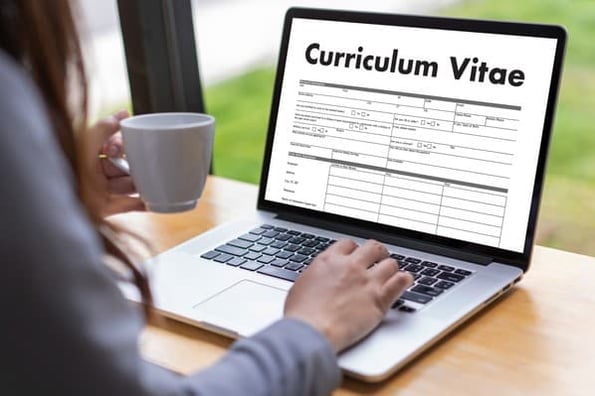
You'll probably wonder what the difference is between the two. Since resumes and CVs both serve as documents that help candidates land new jobs, it is easy to confuse them.
To help you distinguish between the two and choose the proper document for your job application, here's everything you need to know about CVs vs. resumes.
![cv example vs resume → Download Now: 12 Resume Templates [Free Download]](https://no-cache.hubspot.com/cta/default/53/4ec95757-585e-40cf-9189-6b3885074e98.png)
What is a CV vs. a Resume?
Cv vs. resume difference, cv vs. resume format, cv vs. resume examples.
A CV provides the complete history of your academic credentials, career, and qualifications. A resume is a more concise document that focuses on your career, skills, and capabilities as they relate to a specific position.
In regions like Europe and Asia, a CV is the same as a resume, so be mindful when applying for jobs abroad. Now that you know what a CV and resume are, let's explore the differences between the two.
A CV is more in-depth and lengthy than a resume because it gives a more thorough summary of a candidate's career. A resume is more of a "snapshot" of a candidate's professional history and skills relevant to the potential employer.
As a result, CVs are often longer than resumes, which are usually only one or two pages.
CVs are commonly used in the UK, Australia, and New Zealand. They are far less common in the U.S. unless a candidate applies for medical, law, science, or academia jobs.
Resumes have three basic formats that vary depending on the job seeker's goals:
- Functional - Ideal for applicants who are early into their career, are changing careers, or have gaps in their resume.
- Chronological - Ideal for applicants with at least one year of steady work experience.
- Combination - Works best for candidates with more than 10 years of experience who want to showcase their skills and job history.
A CV doesn't have a standard format because the layout depends on the applicant's industry and desired job. For example, a scientist's CV will likely focus more on the candidate's research and published work.
However, a legal CV may highlight a candidate's work history and skills attained at past law firms.
Furthermore, resumes typically have five sections – contact information, professional summary statement or objective, education, skills, and job history.
A CV will also require that information, but some need more sections to adhere to industry norms.
Here's a breakdown of what to include in a CV:
- Your contact information
- A summary of your professional profile
- Detailed work history
- Professional skills
Depending on the industry, you'll also want to include other information such as:
- Publications
- Certificates and licenses
- Volunteer work
- Grants, scholarships, and fellowships
- Teaching and lecturing experience
- Professional associations and memberships
Below is an example of a graphic designer's comprehensive CV.
The graphic designer's CV is two pages long and features standard information expected in a typical resume. It also includes the applicant's past clients, projects, awards, certifications, and volunteer experience.
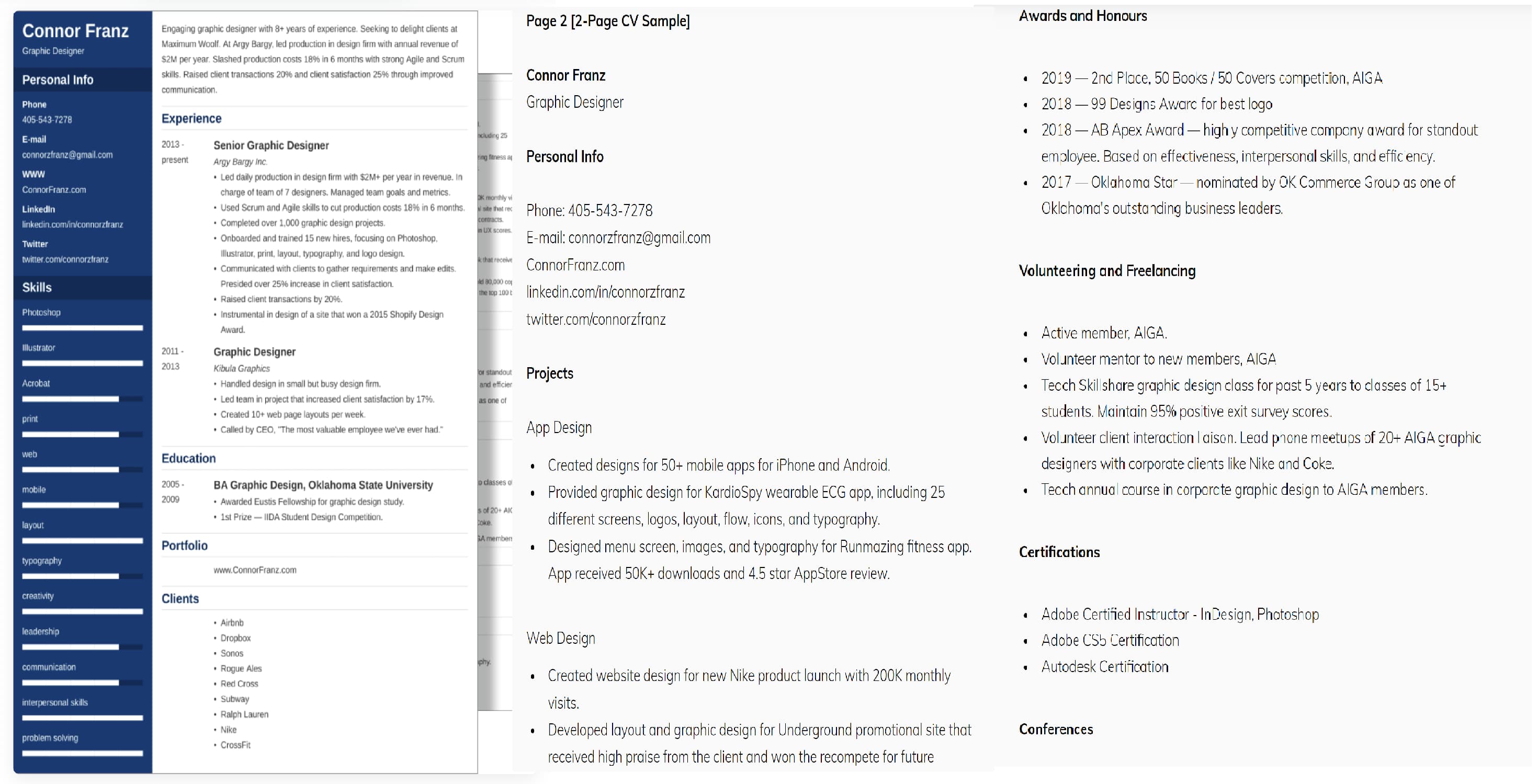
The graphic designer resume below is similar to the CV, but it's kept to one page and only focuses on the applicant's work experience, skills, and education.

Image source
CVs don't have to be two pages long. Like resumes, the length will vary depending on your years of work experience, industry, and what employers want to know. However, it's common for CVs to go into deeper detail than resumes.
And regardless of length, including a cover letter with your resume or CV is strongly suggested.
A cover letter gives you the space to explain changes in your career, gaps in your work history, and a more thorough analysis of your awards and achievements.
Now that you know the differences between a resume and a CV, you can decide which to use for your next job application.
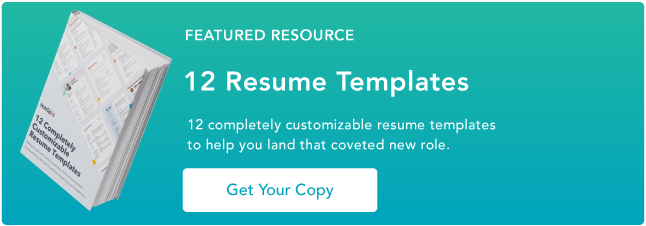
Don't forget to share this post!
Related articles.

The 17 Best Free Resume Builders We've Ever Discovered

40 Free Resume Templates for Microsoft Word (& How to Make Your Own)
![cv example vs resume 27 of the Best Professional Bio Examples I've Ever Seen [+ Templates]](https://blog.hubspot.com/hubfs/Untitled%20design%20%2863%29.jpg)
27 of the Best Professional Bio Examples I've Ever Seen [+ Templates]

Portfolios vs. Resumes — The Complete Guide

40 Interests That Deserve a Place on Your Resume

Making the Most of Electronic Resumes (Pro Tips and Tricks)

How to Write a Simple, Effective Resume (+20 Examples)

How to Write the Perfect Project Manager Resume

How to Write the Perfect Resume for Internships

Maximize Your Impact: 205 Action Verbs to Use on Your Resume
Resume templates to create a killer resume for your job application.
Marketing software that helps you drive revenue, save time and resources, and measure and optimize your investments — all on one easy-to-use platform
- Search Search Please fill out this field.
- Career Planning
- Finding a Job
The Difference Between a Resume and a Curriculum Vitae
:max_bytes(150000):strip_icc():format(webp)/ADHeadshot-Cropped-b80e40469d5b4852a68f94ad69d6e8bd.jpg)
- CV vs. Resume: What's the Difference?
What Is a Curriculum Vitae?
- What to Include in Your CV
Review a Sample CV
What is a resume, review a sample resume, cv and resume writing tips, how to write a successful resume, how to write a successful cv, u.s vs. international cvs, resume and cv examples.
Adrian Mange / The Balance
While both a resume and a curriculum vitae (CV) are used in job applications, they are not always interchangeable. The primary differences are length, what is included, and what each is used for. For example, CVs generally run longer than a resume and are more often used to highlight academic and research credentials.
CV vs. Resume: What's the Difference?
Most resumes in the United States are competency-based ; they are personal marketing documents intended to showcase the candidate’s skills, notable achievements, and work experience to the greatest advantage.
U.S. curriculum vitae, submitted for jobs in academia, scientific research, and medical fields, are credential-based , providing a comprehensive (and often lengthy) listing of one’s education, certifications, research experience, and professional affiliations and memberships.
Like a resume, a curriculum vitae (CV) provides a summary of your experience and skills. However, CVs are typically longer than resumes because they include more information related to one’s academic and research background. For entry-level candidates, CVs can be at least two or three pages long, and CVs for mid-level candidates who have amassed numerous publications tend to run much longer.
CVs include extensive information about your academic background, including teaching experience, degrees, research, awards, publications, presentations, and other achievements.
A curriculum vitae summary is a one-to-two-page condensed version of a full curriculum vitae. A CV summary is a way to quickly and concisely convey one’s skills and qualifications. Sometimes large organizations will initially ask for a one-page CV summary when they expect a large pool of applicants.
What to Include in Your Curriculum Vitae
Your curriculum vitae should include your name, contact information, education, skills, and experience.
In addition to the basics, a CV includes research and teaching experience, publications, grants and fellowships, professional associations and licenses, awards, and other information relevant to the position you are applying for.
Start by making a list of all your background information, and then organize it into categories.
Here is an example of a curriculum vitae. Download the CV template (compatible with Google Docs and Word Online), review more samples , or continue reading for more information.
A resume provides a summary of your education , work history, credentials, and other accomplishments and skills. There are also optional sections, including a resume objective and a career summary statement .
Resumes are the most common document requested of applicants in job applications.
A resume should be as concise as possible. Typically, a resume is one page long , although sometimes it can be as long as two or three pages.
Resumes often include bulleted lists to keep information concise.
There are a few different types of resumes, including chronological , functional , and combination formats. Select a format that best fits the type of job you are applying for.
Here is an example of a resume. Download the resume template (compatible with Google Docs and Word Online), review more samples , or read below for more information.
Whether you are writing a CV or a resume, there are a few helpful rules you should follow. It's important to show the hiring manager how you are qualified for the job, what you have to offer the organization, and why you'd be a terrific candidate to interview.
Match your resume or CV to the position. This is most important when writing a resume, but it applies to a CV too. Make sure that you highlight your education, work experience, and skills as they relate to the particular industry or job.
In a CV, for example, if you are applying for a job in education, you might want to put your teaching experience at the top. In a resume, you might include only the work experience that relates directly to the job you’re applying for. You can also include keywords from the job description in your resume or CV. This will show the employer that you are an ideal fit for the position. The better you can demonstrate your match to the position, the stronger your chances of job search success.
Use a template. You may want to use a template to structure your resume or CV . This will give your document a clear organization, which will help the employer quickly see your qualifications and experience.
Proofread and edit. No matter whether you use a CV or resume, you need to thoroughly edit your document . Make sure there are no spelling or grammatical errors. If you can, ask someone to proofread it for you. It can be hard to catch your own mistakes.
Make sure your format is uniform. For example, if you use bullet points in one job description, use bullet points in all your job descriptions.
- Choose the right format for your needs. Your industry, experience, and desired role will inform your choice of resume format—e.g., chronological, functional, or combination. See sample resumes organized by occupation and industry here .
- Write for both robots and humans. Your resume needs to get past the applicant tracking system and grab the attention of the human being on the other end. These resume writing tips will help you craft a document that appeals to both software and the company's human resources department.
- Know what to include and how to format the information. These sample CVs provide a helpful guide; this piece offers tips for writing your very first CV.
- Choose an appropriate format. Make sure you choose a curriculum vitae format that is appropriate for the position you are applying for. If you are applying for a fellowship, for example, you won't need to include the personal information that may be included in an international CV.
While CVs in the U.S. are used primarily when applying for academic , education, scientific, medical, or research positions or fellowships and grants, candidates for international jobs may be asked to submit CVs for almost any type of job they apply for.
For example, in Europe, the Middle East, Africa, and Asia, employers may expect to receive a curriculum vitae (often with an attached photograph) rather than a resume. However, international CVs are structured and formatted more like a resume than they are an academic U.S. curriculum vitae.
The Main Difference Between U.S. Resumes and International CVs
The primary difference between a U.S. resume and an international CV is that employers in other countries, unfettered by U.S. employment discrimination laws, require more personal information than one would provide on a resume in the United States.
These details vary by country but can include one’s date of birth, nationality, marital status, and number of children. Here’s how to structure your international curriculum vitae.
Review resume and curriculum vitae examples and get downloadable templates for a variety of occupations and types of employment:
- Curriculum Vitae Samples and Templates
- Resume Examples and Templates
CareerOneStop. " Why You Need a Great Resume ."
Challenger Gray & Christmas. " Writing the Modern Resume: Dispelling the Myths ."
CareerOneStop. " Types of Resumes ."
VisualCV. " What to Include in a CV - an International Guide ."
University of Montevallo. " International Resume ."
The opinions expressed are solely those of Find My Profession. Click to see our Advertising Disclosure.
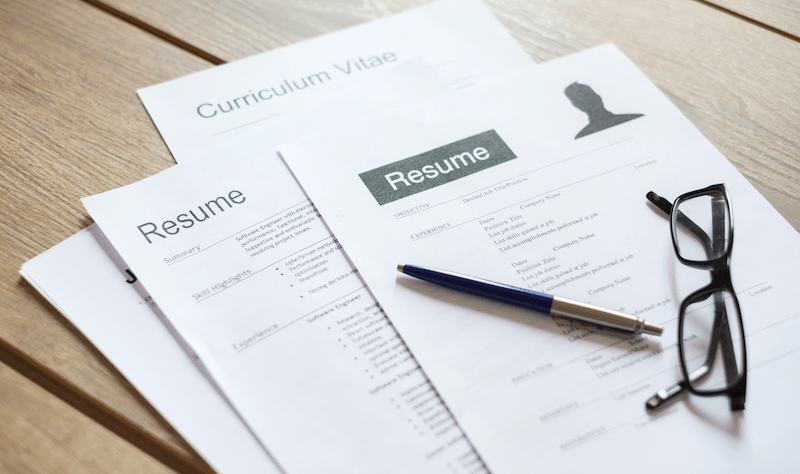
CV vs. Resume: Difference, Samples & When to Use Which
CV vs Resume? Which one is right for you? In this article, we explain the differences and similarities between CVs and resumes. Find CV and resume samples.

In your search for a job, you probably send out your resume dozens of times as you try to land the perfect position.
If you have encountered the term curriculum vitae, a.k.a. CV, your question might be, “How is a CV different from a resume?”
More importantly, could using a CV instead of a resume increase your chances of getting hired?
Which is better, a resume or CV?
In this article, we’ll discuss the similarities and differences between a CV and a resume, provide advice on which one you should personally be using, and offer a few more tips to help you effectively use these essential tools in your job hunt.
What Is a CV?
Let’s start by defining the CV, a document less frequently used in the United States.
CV is short for curriculum vitae, a Latin phrase that means “course of life.”
The very definition should clue you into the fact that a CV is a detailed document that offers a full description of education, work experience, and achievements.
In the United States, you would submit a curriculum vitae for jobs in academia such as postdoctoral positions, and for careers in postsecondary teaching and research fields.
You would also use a CV to apply for fellowships, grants, and certain positions in the medical field.
The CV provides extensive information about your educational and experiential background.
For the most part, if your career requires a CV, you would know about it.
What Is a Resume?
In the United States, we are much more familiar with the resume, but let’s give it a quick rundown.
The word resume comes from the French phrase “to sum up.”
As such, your resume provides a brief summary of your education and experience.
A resume is the most frequently requested document in a job search.
It comes above references and school records, and before any official document such as your driver’s license or social security number.
The average recruiter spends less than six seconds skimming a resume, so it behooves you to create a concise and powerful document that describes your most relevant experience (more on that later).
Despite common belief, it’s okay for a resume to extend beyond one full page, but a resume should almost never be more than two pages.
CV and Resume Similarities
While we devote most of this article to the CV versus resume differences, let’s briefly consider the similarities:
- Both are professional documents aimed at getting you an interview.
- Neither a CV nor a resume should include personal interests.
- With both, your goal is to come across as a qualified and experienced professional.
- You would craft both documents to fit the position to which you are applying.
CV and Resume Differences
Understanding the basic CV versus resume differences is more important than grasping their similarities.
After all, you only get to submit your application to any particular position once, so you want to get it right!
Let’s look at the five main ways in which these two important documents differ:
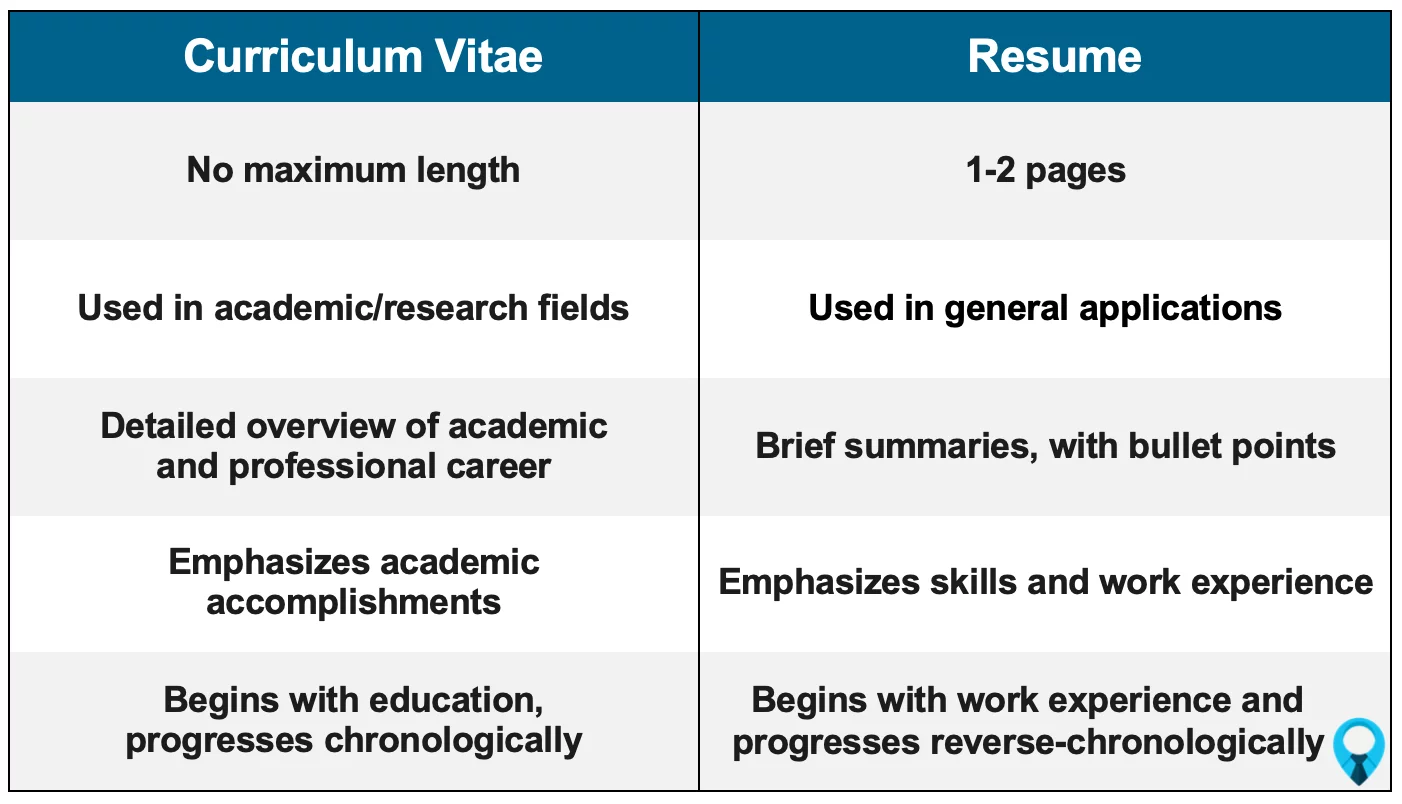
A CV has no maximum length.
A resume should be no longer than one or two pages.
A CV is used in academic fields and for scientific/research purposes.
A resume is used to find a job in just about every other field.
In a CV, you provide an in-depth overview of your academic and professional career.
In a resume, you provide brief summaries. Bullet points are often used. It helps to tailor information to the job application.
4. Emphasis
A CV emphasizes academic accomplishments. Having been published is an important performance indicator. The adage “publish or perish” is valid in many academic circles.
A resume emphasizes skills and professional work experience.
A CV will often begin with education and then progress through each section chronologically (the first job down to the most recent job).
A resume usually begins with your most recent work experience and works in reverse chronological order.
CV or Resume? Which Should You Use?
In your search for a job, it is vital that you submit the proper documentation in your application.
The CV and resume differences outlined above should help you determine which one you should use and when.
In short, in the United States and Canada, you would only use a CV for a few vocations, primarily positions in the field of academia, such as:
- Academic jobs
- Research fellowships
- Postsecondary institutions
Pretty much every other field and industry will require a resume.
In most cases, it should be clear whether you need to submit a CV vs resume. One way to know for sure is to ask some peers within your line of work what they use.
If you are submitting a resume or CV to an international company, pay close attention as to whether they want a CV versus resume.
Whenever you are in doubt, ask!
What to Include on a CV
These are the items you would place in a curriculum vitae, in addition to your contact information:
- Personal statement (a.k.a. professional profile)
- Education and licensure
- Professional experience
- Professional awards and honors
- Grants and fellowships
- Teaching and leadership experience/committee appointments
- Publications, including books, chapters, and peer-reviewed articles
- Conferences and presentations
- Research experience and fieldwork
- Languages and skills
- Professional associations and memberships
With all the above items, you can rightly assume that your CV may end up being far longer than the average resume.
For entry-level positions, a CV might run three or four pages, while someone applying a mid or advanced-level vocation might have a CV that is ten pages long.
After all, you are outlining a “course of life” and may have plenty to show for it!
If the position to which you are applying is in an academic field, you will want to highlight publication information.
If you are applying to a field involving research or medicine, you will also want to highlight research and education.
What to Include on a Resume
Here is what you would put in your resume:
- Contact information
- Professional summary
- Areas of expertise
- Career highlights (optional)
- Professional work experience
- Education and professional development
- Other optional sections may include awards, publications, certificates, and volunteer work.
The formatting of your resume will often depend on the job you are looking for.
The main two formats of a resume are chronological and functional while some job applicants use a hybrid of the two.
(For more on resume styles, read The 7 Different Types of Resumes .)
CV vs. Resume Internationally
You might have noticed that many international companies request a CV instead of a resume.
This is where it might seem tricky, but don’t let the difference in labels confuse you!
Throughout Europe, as well as in the U.K., Ireland, and New Zealand, it is not a matter of “CV versus resume.”
While they use the term CV, they are also looking for a brief vocational summary.
In other words, a resume goes by the name CV in most international locations.
While there are small differences between a United States resume and a European curriculum vitae, they are not significant.
Now in Australia, South Africa, and India, they use CV and resume interchangeably. Both describe a brief, one-to-two-page document outlining relevant professional experience and education.
However, in India and other regions of South Asia such as Bangladesh, hiring companies often also require a “biodata” that outlines more personal information such as date of birth, marital status, nationality, number of children, etc.
Tips for Both CVs and Resumes
Regardless of whether you are creating a resume or CV, here are a few things to keep in mind as you construct either one of these professional documents.
1. Format it carefully
While the content is the most important part of your CV or resume, that content won’t get a second glance if it is not laid out in a visually appealing way.
Pay close attention to the layout and formatting.
- Use bullet points where relevant.
- Avoid lengthy sections of text, especially in a resume.
- Make use of white space if possible.
2. Edit and proofread each section
Nothing is more embarrassing than catching a glaring typo after you’ve submitted your resume or CV.
Print out your resume/CV after you’ve completed it.
- Read over every word and make sure there are no grammatical errors.
- Give a close read to dates and numbers; it’s easy to miss mistakes here.
- Ask someone to give it a second read to catch anything you might have missed.
3. Update your resume and CV regularly
Set aside time on a regular basis to update these important documents.
Otherwise, you might catch yourself looking for a job and finding it impossible to remember the exact dates of your last few positions or your most recent publications.
My recommendation is to update your resume or CV on a quarterly basis.
- Open up the file on your computer and look through your most recent data.
- If nothing has changed, you’re good to go.
- If you have any new information, add it to the section(s) where it belongs.
Tips to Write a CV
Below are some tips for writing a top-notch CV.
- Create a comprehensive list of your professional and educational history.
- Place it into the categories listed in the above section, “What to Include on a CV.”
- Organize your CV in chronological order.
- Update your CV each time you receive an award or have an article or book published.
Other than these updates, most sources recommend that you do not need to change your CV for each position.
However, you might need to choose a different format depending on the type of position you are seeking.
For example, the sections you would add for a fellowship application would be different than if you are applying for an academic job position.
Tips to Write a Resume
Below are some tips for writing a top-notch resume.
1. Tailor your resume to the position
Now, in order to keep your resume as “short and sweet” as a recruiter expects, you usually can’t list every single job you held or all the experience you have.
It simply wouldn’t fit!
This is why it is important that you tailor your resume to the job application.
As a general rule of thumb, work experience that dates back more than 10 or 15 years should be entirely removed from your resume.
2. Make your resume ATS-friendly
Many companies use an applicant tracking system (ATS) to scan resumes.
This is before a recruiter or hiring manager even takes a look.
If you want your resume to pass ATS scans, use enough relevant keywords and ensure that your resume formatting is ATS compatible.
Take a look at an example curriculum vitae for a clinical leader courtesy of Find My Profession. Download the CV to see all four pages.
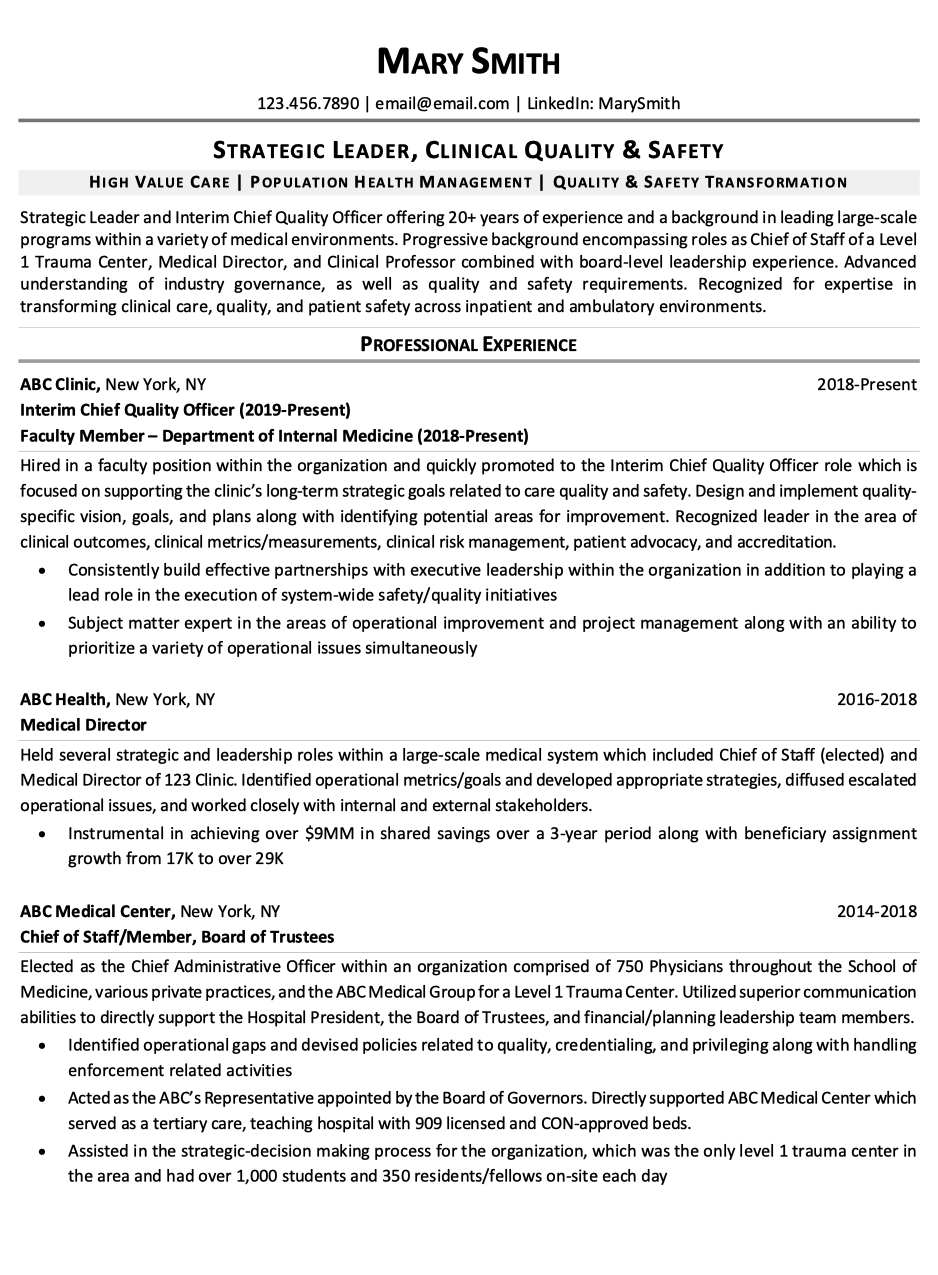
Sample Resume
Take a look at an example Chief Executive Officer resume courtesy of Find My Profession. Download the resume to see both pages.
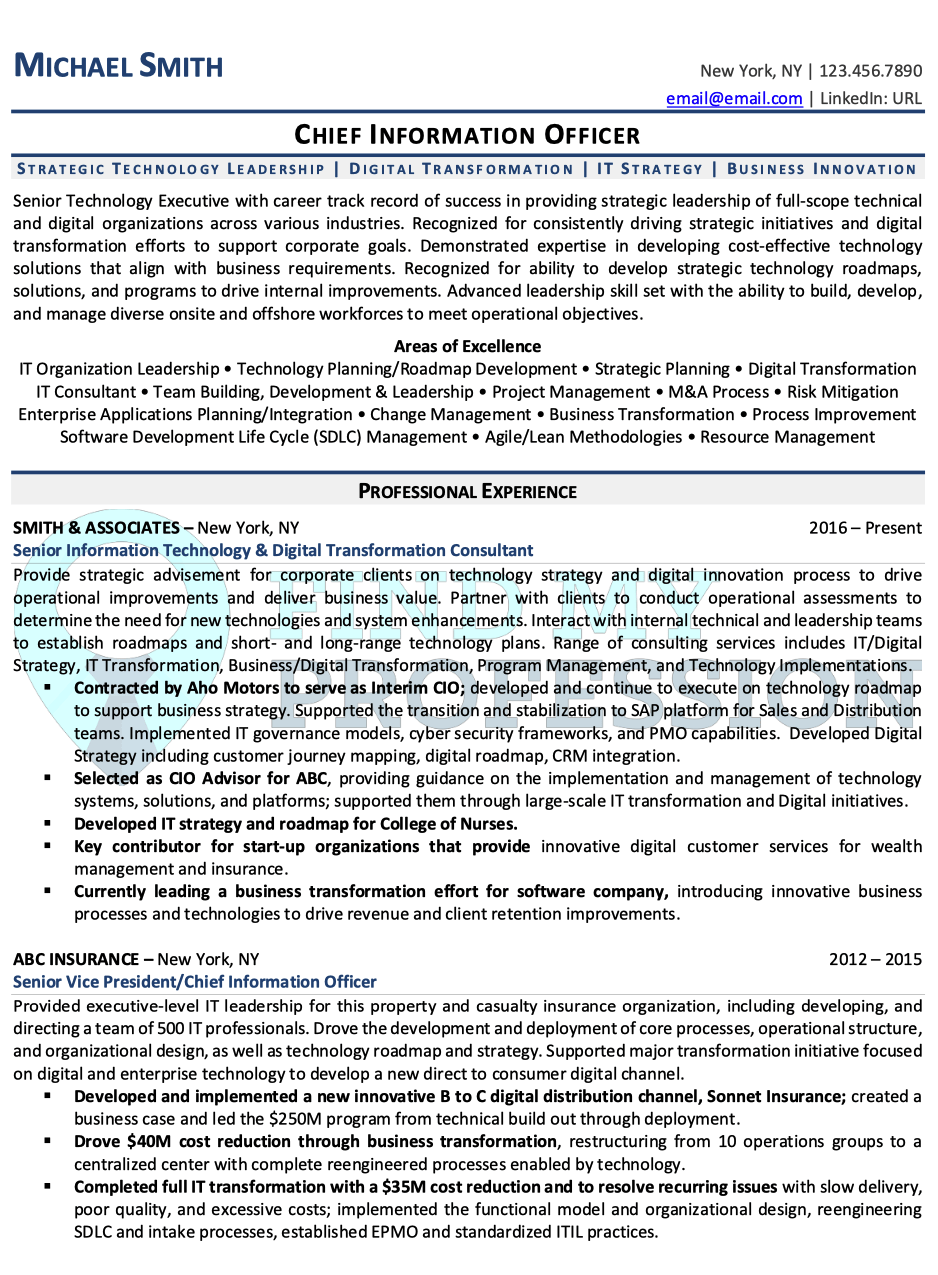
Closing Thoughts
So, how is a CV different from a resume?
In many ways!
Now you know it is not a case of “CV versus resume” but more a matter of which one you should use, and when.
- When applying for a job in the United States, submit a resume that is concise and tailored to the position.
- If looking for an academic position, submit a comprehensive curriculum vitae detailing your education, publications, and professional history.
- If applying for a position in Europe or New Zealand, submit a CV that follows the format of the resume you would use in the United States.
- When applying for a job in Australia or South America, submit a resume (which might be referred to interchangeably as “resume” or “cv”).
If you’re still having difficulty in the question of curriculum vitae versus resume, or if you have any resume/CV questions please feel free to contact us.
Here at Find My Profession, we offer professional resume and CV writing services that are ATS compatible and come with a 60-day interview guarantee.
We would love to assist you in landing your dream job.
Recommended Career Advice For You
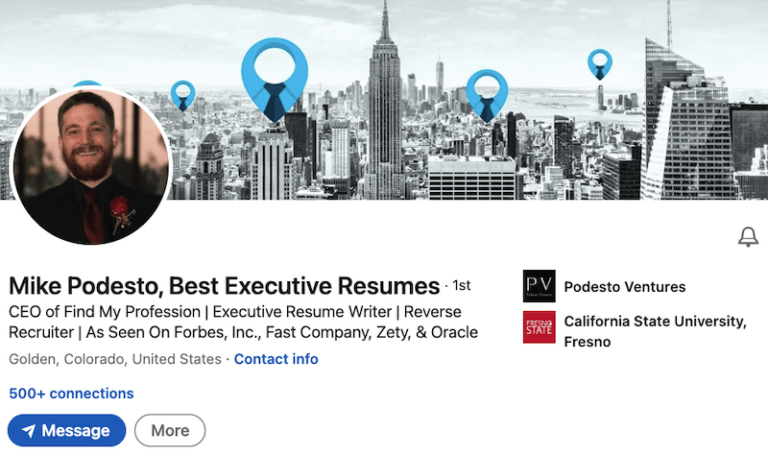
19 Top LinkedIn Profile Tips for Job Seekers

5 Best Chief Operating Officer Resume Writing Services (2024)
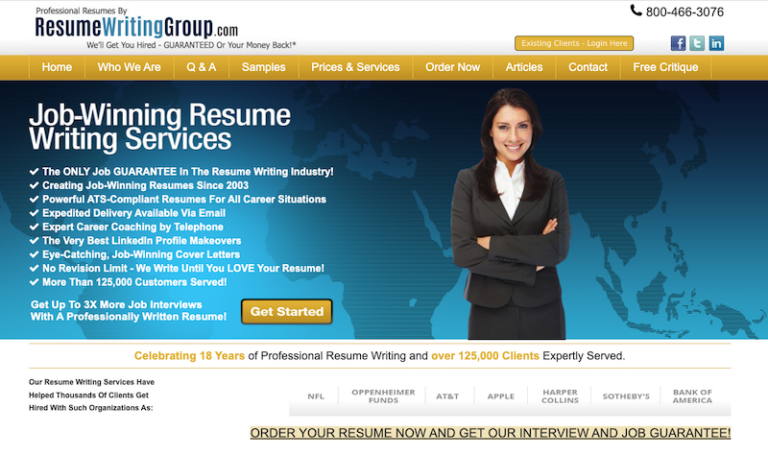
Resume Writing Group Review [Cost + Customer Reviews]

Curricula Vitae (CVs) versus Resumes
What this handout is about.
This handout explains what a curriculum vitae (CV) is, how it differs from a resume, and how you can decide which one to use. It also includes a list of campus resources, helpful online tips, and recommended reference books. (Please note that this handout covers American usage of the terms “CV” and “resume.” The word “resume” may also be spelled “resumé” or “résumé.”)
Before you start
To decide whether to submit a CV or a resume, you will need to determine which of them most appropriately fits the criteria provided by the employer, grant agency, or scholarship or internship committee who will be reading your application. Often, the application instructions for a particular position will state whether a CV or resume is requested. If you are unsure, it is worth your time to contact the agency and ask which would be most appropriate for the position.
What is the difference between a resume and a CV? What do they typically include?
Let’s start with a quick overview of resumes, since they are more familiar to most American writers than CVs. A typical resume is a general and concise introduction of your experiences and skills as they relate to a particular career or position that you are aiming to acquire. As such, a resume may have to be altered for each position that you are applying for so as to emphasize those skills and experiences most relevant to the work. Resumes are usually no more than one page in length. They are often accompanied by cover letters , which provide a permanent written record of the transmittal of the resume (what is being sent, to whom it is being sent, and who sent it).
A typical resume will include the following information:
- Name and Contact Information: your residential address might be most appropriate, especially if you do not want your current employer to know that you are looking for another job!
- Education: a listing of your degrees or certifications and educational institutions or programs.
- Work Experience: names of the companies or organizations that you have worked for, the location of each company, the dates worked, your job title, and duties performed.
In contrast, a CV is a fairly detailed overview of your life’s accomplishments, especially those most relevant to the realm of academia. As such, these documents have their greatest utility in the pursuit of a job in academia or research. Because academic researchers are often working on and completing many projects and teaching responsibilities simultaneously, it is wise to think of a CV as a living document that will need to be updated frequently. A typical CV for someone in the beginning stages of their graduate school career might only be two or three pages in length, while the number of pages of a more seasoned researcher’s CV may run into the double digits. In both CVs and resumes, information within sections is usually organized chronologically.
A typical CV will include the following information:
- Name and Contact Information: contact information for your current institution or place of employment may work best, unless you do not want your colleagues to know that you are job-hunting.
- Areas of Interest: a listing of your varied academic interests.
- Education: a list of your degrees earned or in progress, institutions, and years of graduation. You may also include the titles of your dissertation or thesis here.
- Grants, Honors and Awards: a list of grants received, honors bestowed upon you for your work, and awards you may have received for teaching or service.
- Publications and Presentations: a list of your published articles and books, as well presentations given at conferences. If there are many of both, you might consider having one section for publications and another for presentations.
- Employment and Experience: this section may include separate lists of teaching experiences, laboratory experiences, field experiences, volunteer work, leadership, or other relevant experiences.
- Scholarly or Professional Memberships: a listing of the professional organizations of which you are a member. If you have held an office or position in a particular organization, you can either say so here or leave this information for the experience section.
- References: a list of persons who write letters of recommendations for you, which includes their contact information.
Additional considerations
Use common sense when formatting.
There are no universal guidelines for how to format or organize a resume or CV. However, some commonsense guidelines may apply. If you are concerned that your resume or CV might appear too busy or misaligned, click on Print Preview in your word processing program and evaluate the consistency of your use of space in the document.
Fonts and font sizes: go with the flow
It is a good idea to stick to commonly used fonts such as Times New Roman or Arial when creating a resume or CV. Fonts such as Bauhaus or Old English Text might have their place in other writing projects, but these might distract the reader and pull their attention away from the content you want them to read. Perhaps with the exception of your name, the use of a uniform font size throughout the document will also keep the reader focused on your accomplishments.
Seek and evaluate examples
Many professors and professionals have posted their CVs and resumes to online faculty web pages, bulletin boards, and employee profile pages on corporate websites. These documents, often posted as Adobe PDF files, are useful templates for designing your own CV or resume. It is best to search for a CV or resume of an individual who shares your field, discipline, or interests, as it will provide you with a model that most closely approximates what your final document might look like.
Campus resources at UNC
University career services (careers.unc.edu).
At University Career Services, located on the second floor of Hanes Hall, you will find a friendly staff and a thorough assortment of resources for creating and sharpening your CV or resume. Individual appointments are also available. In addition, Career Services offers some online resources to help with your CV or resume.
UNC General Alumni Association (alumni.unc.edu)
Do you expect to graduate in the foreseeable future? In addition to making an appointment with University Career Services before throwing your cap in the air, a visit to the Career Services branch of the UNC General Alumni Association in the George Watts Hill Alumni Center might turn into a wise career move. After graduation, members of the GAA are eligible to receive resume tips and samples, as well as to take advantage of their resume posting service.
Works consulted
We consulted these works while writing this handout. This is not a comprehensive list of resources on the handout’s topic, and we encourage you to do your own research to find additional publications. Please do not use this list as a model for the format of your own reference list, as it may not match the citation style you are using. For guidance on formatting citations, please see the UNC Libraries citation tutorial . We revise these tips periodically and welcome feedback.
Jackson, Acy, and Kathleen Geckeis. 2003. How to Prepare Your Curriculum Vitae , 3rd ed. Columbus, OH: McGraw-Hill.
Rosenburg, Arthur. 2007. Resume Handbook: How to Write Outstanding Resumes and Cover Letters for Every Situation , 5th ed. Cincinnati, OH: Adams Media.
Thompson, Mary Anne. 2000. The Global Resume and CV Guide . Ridgewood, NJ: Wiley.
Vick, Julia Miller, Jennifer Furlong, Rosanne Lurie, and Mary Morris Heiberger. 2016. The Academic Job Search Handbook , 4th ed. Philadelphia: University of Pennsylvania Press.
You may reproduce it for non-commercial use if you use the entire handout and attribute the source: The Writing Center, University of North Carolina at Chapel Hill
Make a Gift
Government agencies communicate via .gov.sg websites (e.g. go.gov.sg/open). Trusted websites Trusted websites
Look for a lock ( ) or https:// as an added precaution. Share sensitive information only on official, secure websites.
5 minute read
What Is the Difference Between a CV and a Resume?
Submitting a stellar curriculum vitae and resume can propel one through the job application process. we discuss the differences between the two formal application documents for jobseekers looking to impress recruiters..

Finding yourself questioning the difference between a curriculum vitae (CV) and a resume? Part and parcel of most job application processes include the submission of your current resume and/or a CV.
Complementary to each other, these formal documents are decision-makers in the competitive job market.
The benefits of a well-worded resume and CV are notable. Apart from standing out from a pool of job candidates, these application materials must be optimised for applicant tracking systems . Such tools help hirers automatically narrow down the most relevant resumes and CVs to streamline the vetting process.
Thereafter, hiring managers spend an average of six seconds on a resume or curriculum vitae before deciding on a jobseekers’ eligibility, according to New York-based recruitment agency Ladders.
To make those few seconds count, you have to convince hiring managers that you possess the right skillset required to excel in their organisation.
Despite the simplicity of their objectives, many spend days, even months, working on these application documents, perfecting their draft for a dream job.
Before understanding what goes into writing a stellar resume and updating your CV , understanding the differences between the two is important.
CV vs Resume
CV and resumes share the common purpose of marketing jobseekers as desirable employees who will meet and exceed the expectations of potential employers.
However, these application documents are not interchangeable, as major differences exist between them. Understanding the key differences between a CV and a resume can help you structure and draft them.
The primary differences between CVs and resumes are:
- Information included, such as your educational history, career biography and professional qualifications
Get professional support in getting your CV or resume right for your job applications. Register to speak to our career coaches now!
What is a Curriculum Vitae?

Commonly referred to as a CV, the curriculum vitae is a detailed overview of your academic and professional life. Ever-expanding, a well-polished CV is constantly updated as you amass experiences and accomplishments.
As with the plethora of CV samples available online, their length may differ depending on the experiences accrued.
How to write a CV?
On average, recruiters receive 250 CVs for a job position . With trained eyes, hiring managers quickly scour through them for specific information – thus, yours should be clear and concise.
Typically credential-based, the comprehensive, multi-page document should include information on your educational accomplishments, professional achievements and work performed in chronological order.
The best CV samples contain relevant and up-to-date information such as:
1. Personal information and contact details
Remember to include your full name, nationality, telephone number and email address. You may leave out your residential address for privacy reasons unless required.
76% of CVs with an unprofessional email address get overlooked, so make sure to include your contact details in your job applications. Avoid including redundant information such as religious beliefs and salary history.
2. Education certifications and other qualifications
Begin listing your education details, starting with your latest qualification, and state the institution and duration of your attendance with the month and year (i.e. Jan 2019 – Mar 2021).
3. Career history
A common misconception among jobseekers is that only paid stints make the cut as valid job experiences. This cannot be further from the truth. Internships, job shadowing, part-time jobs and other forms of employment opportunities can be listed.
This guide shows how fresh graduates or entry-level candidates can secure a job even without work experience .
When it comes to describing your work experience, follow these basic rules:
- Arrange in chronological order, with the most current employment at the top and the time you worked in each company. Use the duration format applied in the education section.
- Explain each job experience in bulleted lists for an easier read while providing detailed descriptions of your role.
- Include both your responsibilities and accomplishments. Be sure to illustrate your experience in a way that highlights your skillsets, especially your soft skills like communication, people management and leadership.
4. Skillset
From language capabilities to IT literacy , showcase hard critical skills that demonstrate your depth of knowledge to your future interviewer. You may have a section to list them alongside your proficiency levels.
When it comes to your soft skills, it is best to describe them through examples within your career history. For example, instead of listing “multi-tasking” or “collaboration” as key skills, talk about the projects you worked on and your role in making those projects a success.
5. Other relevant experience, training and references
Scholarships, awards, memberships, relevant coursework and other miscellaneous qualifications can be fully recorded.
Get more resume or career tips like this from our Telegram community! Click to join and level up your job-hunting game.
What is a resume?
It is said that first impressions count — this is exceptionally so for resumes. In many cases, it is the first application document a recruiter evaluates, and a good one should convince them to read your curriculum vitae for additional information.
Think of a resume as an elevator pitch that will get you a profitable career. Short and concise, the document is a personalised representation of yourself for a specific role — though an extension of you, it should be tailored for the recipient.
Consider the resume as a concise overview of your CV.
How to write a resume?
A well-crafted resume should contain the same information as your CV, but be crafted strategically. Aimed at demonstrating competence, you have to actively pick out relevant information that showcases your strengths and abilities in the best light.
Compared to the static CV, your resume should be adapted and tailored to every position you apply for. The best way to accomplish this is to study the job requirements closely.
Consider these when drafting your resume:
1. Template
Unlike a CV that is written in chronological order, there are four resume templates that jobseekers can follow. These include:
- Chronological resume format
- Functional resume format
- Combination resume format
- Targeted resume format
Similar to the CV, each job description should be accompanied by bulleted lists of your professional experience, made relevant to the role you’re applying for.
Depending on your preferred resume format, you can then find relevant sample resume examples as references when writing your own. Here are a few resume writing tips to guide you.
A standard resume succinctly states career objectives, what you have to offer, and other relevant information. Keep your resumes to a one or two-page document as long resumes may hurt your job prospects .
3. Customisation
You should find ways to align your resume to the job description . The targeted resume template will perfectly complement this pivotal factor.
A targeted resume is customised to the job position and industry. This gives jobseekers the flexibility to highlight relevant qualifications and experiences that demonstrate they are the best fit for the job.
4. Digital Formats
A soft copy, for example, a PDF document of your resume, is typically the go-to when sending your job applications via the internet. Alternatively, consider other ways to create an online resume , such as through a resume website.
A resume builder app can also help you put together a job-winning document.
A complete list of primary differences: CV vs resume
We outline the distinct difference between a CV and a resume below based on the relevant sections, emphasis and the length of each document:
Show your personality
Ultimately, despite the myriad of CV and resume tips and samples available online, it is crucial to add personality and indicate that you are in it for the long haul.
You also want to ensure that your CV and resume are free of grammar errors. This proofreading checklist offers an in-depth guide on what content errors to look out for.
Make your achievements as concrete as possible so that they remain tangible to the hiring managers. Working on our professional story through your CV and resume will take you far.
Update your current resume and CV with our career resources today and enhance your job search!
Related topics:

Resumes: Yes, Leonardo Da Vinci Wrote the First One And Why They Still Matter for Job Hunting

Here Are the Top Tech Skills You Need for Your Resume
4 minute read
Quick share
Enjoyed reading this? View other related articles below:
Tips for new entrants joining the workforce

3 Ways to Embrace Imperfections for Growth

25 Soft Skills That Will Make Your Resume Stand Out

5 Smart Ways for Fresh Graduates to Nab the Job They Want
6 minute read
Advice for managing your mid-career development

Career Confessions: How a Former Musician Found His Harmony in Cybersecurity
12 minute read

Juggling Study with Work Mid-Career Can Be Tough. Here’s Some Advice (PODCAST)

Career Cushioning: Why It’s Trending, and How It Matters to Career Resilience
Insights for mature workers to stay relevant

6 Tips Mature Workers Can Use to Reinvent Their Careers

Career Confessions: Grit, Gratitude and Gumption Helped Him Overcome His Physical Disability
20 minute read

Singapore’s Ministry of Manpower’s Gameplan to Boost Local Workers’ Career Prospects in 2024
Home / What Is the Difference Between a CV and a Resume?
Find more jobs like these at MyCareersFuture Job Portal

An initiative by Workforce Singapore
Whether you are a fresh graduate searching for a new entry-level job or a seasoned veteran considering a career switch, Workipedia by MyCareersFuture is the one-stop website for all your job application needs.
30 Best Personal Skills for Your Resume [Examples]

3 key takeaways
- Personal skills are often referred to as soft skills.
- Soft skills include qualities like leadership, teamwork, and time management.
- Build a better skills section in your resume with Teal’s AI Resume Builder .
You've spent hours crafting the perfect resume, highlighting your professional and personal skills. But the interview invites just aren’t coming. While technical skills and experience are necessary, personal skills are equally important for standing out in a crowded market.
Personal skills for a resume showcase your ability to work effectively with others, communicate clearly, and adapt to new challenges. They demonstrate to employers that you're not just qualified on paper but will also work well within a team.
You could be overqualified in terms of experience and technical skills and still not get the job due to lacking people skills. Ultimately, the hiring manager will hire someone that complements the current team.
In this guide, you'll learn:
- Top personal skills to add to a resume
- How to decide which personal skills to add to your resume
- How to format and write personal skills on a resume
Struggling to land interviews with your resume? Get started with Teal’s AI Resume Builder for free.
Understanding personal skills
Personal skills, also known as soft skills , are transferable abilities that show how you interact with colleagues and contribute to a positive work environment. Imagine a team brainstorming session—your communication skills help you exchange ideas, while teamwork lets you build on each other's contributions. Both competencies rely on personal skills.
Personal skills are used in everyday situations at work, from managing projects to effectively resolving conflicts with teammates or clients.
In one survey by Business Name Generator , 84 percent of employees and managers thought soft skills were important for new hires. By highlighting strong personal skills on your resume, you show employers you're a well-rounded professional who can integrate into their team.
Personal skills vs professional skills
Professional skills, also known as hard skills , are the technical abilities specific to your job or industry. Think coding languages for a programmer, design software for a graphic designer, or financial knowledge for an accountant. If you’re applying for an open role, these skills demonstrate your proficiency in tasks directly related to the position.

The main difference between personal and professional skills lies in their focus. Personal skills highlight how you work with others and navigate challenges as well as your own innate qualities. Professional skills, on the other hand, demonstrate your technical expertise specific to the job or industry, like knowledge of a particular software program or financial analysis.
Here are a few different personal and professional skill examples:
Personal skills examples for resume
- Communication
- Problem-solving
- Time management
Professional skills examples for resume
- Programming languages
- Graphic design
- Cybersecurity
- Data analysis
- Writing skills
Some skills are both personal and professional, for example:
- Critical thinking bridges the gap between analyzing a problem (personal) and building a solution (professional).
- Decision-making has aspects of choosing a deadline for a project (personal) or deciding what software to use (professional).
- Problem-solving requires both the ability to come up with creative solutions (personal) and have technical or professional expertise (professional).
A well-crafted resume balances both soft and hard skills, proving you're a well-rounded professional with the technical chops and collaborative spirit to excel.
.png)
Imagine two equally qualified candidates on paper. Both have the technical skills and experience listed in the job description. But one candidate stands out. Their resume highlights strong personal skills throughout the bullet points, showing off their ability to collaborate effectively, communicate clearly, and adapt to new challenges. This gives the hiring manager confidence the candidate will fit long-term. This is the importance of personal skills in a resume.
From communication and teamwork to problem-solving and adaptability, highlighting strong personal skills creates a more compelling resume, so you stand out as a job seeker.
Top list of personal skills for a resume
Of course, you should only include personal skills you really possess on your resume. At the same time, a resume is your sales pitch. Demonstrate your strongest personal skills rather than listing every single trait.
Here is a comprehensive list of in-demand personal skills to consider when writing your resume.
1. Communication
Communication skills refer to the ability to express ideas clearly and concisely, both verbally and in writing. This allows everyone involved in a project to understand the situation, ask insightful questions, and contribute their expertise.
2. Teamwork
Teamwork as a skill involves collaborating with colleagues from diverse backgrounds and valuing their strengths. According to a survey from NACE (National Association of Colleges and Employers), nearly 80 percent of employers are looking for candidates with teamwork skills, especially for new graduates.
3. Interpersonal
Interpersonal skills let individuals connect with people from all walks of life, building a harmonious teamwork atmosphere. This skill allows people to connect with others and demonstrate empathy and understanding.
4. Active listening
Active listening is a valuable workplace skill. It's the act of listening with the intent to understand someone else's perspective and needs. With active listening, individuals ensure clear communication and effective collaboration so everyone feels heard and valued.
5. Negotiation
Strong negotiation skills allow individuals to navigate challenging conversations with diplomacy and respect. Negotiation uses compromise and creative problem-solving to find mutually beneficial solutions that satisfy all parties.
6. Conflict resolution
Conflict resolution skills involve effectively addressing disagreements by facilitating open communication and listening to all perspectives. In addition to a useful team skills, this is one of many valuable customer service skills.
7. Leadership
Leadership skills allow someone to motivate and guide their team toward a common goal, setting a clear vision and providing ongoing support and encouragement. True leaders don't just tell people what to do, they inspire them to achieve more, resulting in greater business results.
8. Project management
Project management skills allow individuals to excel at organizing tasks, prioritizing effectively, and managing timelines. By keeping team members aligned and focused on project goals, they ensure a smooth workflow and successful project outcomes.
9. Analytical
Individuals with strong analytical skills can dissect data, identify trends and patterns, and uncover the root causes of problems. Having an analytical mind, coupled with critical thinking skills, allows someone to develop effective solutions and make informed decisions.
10. Problem-solving
Problem-solving skills include the ability to actively identify, analyze, and overcome obstacles, both independently and as part of a team. While challenges are inevitable in any workplace, with the right problem-solving skills, they can promote opportunities for growth.
11. Decision-making
Effective decision-making skills separate good performers from great ones. This skill gives an individual a keen ability to weigh options, assess risks and benefits, and make sound choices in a timely manner, ensuring progress and avoiding costly mistakes.
12. Initiative
Having initiative allows people to proactively identify tasks that need to be done and take ownership of them without needing constant direction. This quality is highly valued in fast-paced work environments.
13. Resourcefulness
Resourcefulness refers to the ability to find creative solutions even when faced with limited resources. Resourceful individuals excel at thinking outside the box, brainstorming unconventional approaches, and leveraging existing tools in innovative ways.
14. Adaptability
Adaptability involves adjusting to new situations, learning new skills quickly, and navigating changes in processes, technologies, or even company culture. This flexibility allows people to integrate into new teams, adopt updated workflows, and contribute effectively in any environment.
15. Time management
Time management skills allow someone to prioritize tasks effectively, manage their schedule meticulously, and meet deadlines consistently. This skill allows someone to juggle multiple responsibilities, allocate time efficiently, and make sure every task receives the attention it needs without sacrificing quality.
16. Organization
Organization skills are about managing information efficiently and prioritizing tasks well, demonstrating strong planning and task management skills. A detail-oriented approach lets someone move deftly between projects while maintaining a productive workflow.
17. Empathy
Empathy refers to connecting with others on an emotional level, understanding their feelings, and sharing their perspectives. Having emotional intelligence creates a supportive and understanding work environment where everyone feels valued and respected.
18. Integrity
Integrity is about demonstrating honest and ethical behavior in all actions. This skill builds trust and respect with both colleagues and clients. Honesty and integrity are the foundation of strong relationships, and people with integrity act with transparency and fairness in all their interactions.
19. Attention to detail
Attention to detail means a keen eye for accuracy and making sure tasks are completed meticulously, with a commitment to quality and precision. People who value attention to detail take pride in their work and go the extra mile to make sure every deliverable meets high standards.

20. Work ethic
Work ethic is evident in dedication, reliability, and an unwavering commitment to delivering quality work. Individuals with a strong work ethic consistently go above and beyond the minimum requirements, taking initiative and putting in the extra effort to achieve outstanding results.
21. Accountability
Accountability means always delivering on promises, which builds trust and reliability within a team. Accountable individuals can admit mistakes, learn from them, and take steps to improve themselves.
22. Positive attitude:
Maintaining a positive and optimistic outlook creates a supportive and motivating work environment. These individuals inspire those around them, encouraging and empowering everyone to do their best. While challenges happen, people with a positive attitude focus on solutions and maintain a "can-do" spirit.
23. Emotional intelligence
Emotional intelligence is a skill that allows individuals to understand and manage their own emotions, as well as recognize and respond to the emotions of others. This creates a healthy workplace culture by letting people build strong and positive relationships with colleagues.
24. Level-headed
Being level-headed is about remaining calm and collected under pressure. Deadlines and demanding situations aren’t a problem. Level-headed individuals cope with stress and maintain their composure in challenging situations, prioritizing tasks effectively, thinking clearly under pressure, and making sound decisions even when faced with tight deadlines.
25. Delegation
Delegation skills are about providing clear instructions, ongoing support, and opportunities for independent problem-solving. Delegation allows someone to effectively assign tasks to others based on their strengths and development needs.
26. Reliability
Reliability involves consistently delivering on commitments, exceeding expectations, and earning the trust of colleagues. People know they can count on these individuals to dependably complete tasks on time and to a high standard.
27. Creativity
Creativity as a skill is the ability to develop innovative solutions to problems. Creative individuals excel at brainstorming unconventional approaches, challenging assumptions, and finding new and improved ways of doing things.
28. Motivation
Motivation means being driven to achieve goals and go above and beyond at work. Highly motivated individuals have a genuine passion for their work, creating a more positive and productive work environment.
29. Curious
Curiosity is about having a continuous desire to learn new skills and knowledge. Curious individuals are proactive in seeking out training opportunities, embracing new technologies, and staying up-to-date on industry trends.
30. Flexible
Flexibility is the ability to adapt based on changing circumstances. Flexible people are great at thinking on their feet, adjusting their work style to new situations, and finding creative solutions to unexpected problems.
For more examples of skills that you can include in your resume, download our free skills workbook .
How to write personal skills on a resume
Relevant experience is a must when it comes to landing the right job. But what truly sets you apart are your personal skills, the qualities that demonstrate how you function within a team and contribute to a positive work environment. Follow these tips to best showcase your skills on a resume.
Step 1: Identify relevant personal skills
First, carefully read the job description. Analyze it to identify key personal skills and qualities that the employer is looking for.
Look for opportunities to showcase the skills the company values most in your resume skills section . You can do this faster with Teal’s Matching mode!
Within Matching Mode in the Resume Builder, you can select a job from your job tracker to match against your resume. You’ll automatically get a list of highly relevant keyword recommendations that you can add to your resume.
Step 2: Choose powerful verbs
Replace bland words like "skilled" or "helped" with action verbs that showcase initiative and achievement, such as "spearheaded," "implemented," or "directed."
“Orchestrated the adoption of a new payroll software company-wide, leading to a 40% time savings.”
Pro Tip: Use Teal's AI Achievement feature to write impressive resume achievements in seconds.
Step 3: Quantify your impact
Quantify your resume by adding results. Did your communication skills lead to a 20% increase in project efficiency? Highlight measurable achievements to strengthen your claims.
“Increased website conversion rate by 12% through A/B testing and website optimization strategies.”
Step 4: Tailor to the job
Don't overwhelm your resume by randomly stuffing words into your experience section. Aim to highlight the top skills that best represent your strengths and align with the job requirements.
According to Teal’s Director of Talent Mike Peditto , “While there isn't a magic number of skills, a long list can become overwhelming and take focus away from the top skills needed for a job. Focus on the skills that appear early and often throughout the job description. Here, you'll likely find the top five to eight skills the job is asking for, above all else.”

Try to personalize your skills section for each job application, emphasizing the skills most relevant to the specific role.
Step 5: Craft compelling descriptions
Structure your skill descriptions using action verbs followed by a specific example of how you used that skill to achieve a positive outcome. Don't just list responsibilities—show what you accomplished or what results you achieved.
"Built rapport with a diverse clientele, resulting in a 15% increase in client retention rate.”
Tips for using personal skills on your resume to attract recruiters
Follow these tips to use your personal skills to stand out to recruiters and hiring managers:
- Include relevant personal skills from the job description throughout your resume, but avoid keyword stuffing.
- Identify existing personal skills that overlap with the job description so you can demonstrate a strong fit for the role. You can use Teal’s Matching Mode in the Resume Builder to choose a job and automatically analyze the job description to find the skills the company values the most.
- Provide specific examples from your work experience. Instead of listing "problem-solving skills," describe a challenge you tackled successfully and its impact on the business.
- Highlight skills consistently throughout the application process, from your resume, cover letter, and interviews. Your resume is only one part of the job search process.
Teal's Matching Mode feature makes it easy to surface relevant hard and soft skills within a job description to add to your resume. It will also help you identify where the overlap lies, so you can quickly add the ones you really possess.
The best way to add personal skills to your resume
Using an AI Resume Builder like Teal can speed up the process of adding the right personal skills to your resume.
From the Resume Skills Management feature within the Resume Builder, you can add skills to your resume, or even group them together by adding a category. Drag and drop the skills to rearrange them or toggle a button to sort them from A-Z automatically.
If you’re not sure what personal skills to highlight on your resume, head over to the Matching tab at the top of the screen, then choose a job from your job tracker.
From here, Teal’s AI-powered Matching Mode will suggest what skills and keywords you should add to your resume based on the job description. Aim for an 80 percent match score.

Personal Skills Examples for Your Resume
Beyond specific job skills or technical expertise, job seekers also need to bring personal skills to the table. Here are some examples of how professionals can showcase personal skills in their resume, whether you’re a new graduate or a seasoned professional.
For an experienced professional
One common personal skill to highlight as an experienced professional is leadership. Experienced professionals are expected to guide and support others, so it’s important to demonstrate leadership skills, especially when applying to management-level roles.
For example, a bullet point on your resume could look like this:
“Successfully mentored and coached junior team members, contributing to their professional development and increasing team productivity by 20%."
For a new graduate
As a new grad, your work history might be lighter, but you can still highlight personal skills like teamwork. Teamwork is an important skill in just about any job. As a new grad, whether you’ve completed internships or group projects in class, this is a skill you can highlight in your resume.
For example, you could write a bullet point for a past internship like this:
“Collaborated effectively with a team of five to develop an Instagram strategy that increased engagement by 40%.”
For a professional targeting a technical role
Be sure to highlight personal skills that complement your hard skills when applying to technical positions. Whether you’re applying for a job as a data analyst, a software engineer, or something else, highlighting your analytical skills demonstrates your ability to approach challenges logically and strategically.
For example, you might want to demonstrate that you have a strong analytical mind. A bullet point on your resume could look like this:
“Analyzed customer data to identify trends and inform strategic decision-making, resulting in a 10% improvement in customer satisfaction.”
To further improve soft skills for your career, read our guide on interpersonal skills .
Yes, you should add personal skills to your resume
Work experience might be the foundation of your resume, but strong personal skills are key to landing your next job. However, crafting a resume that effectively showcases these skills can be tricky.
That’s where Teal makes your life easier. With Teal’s AI Resume Builder , you can not only create a detailed skills section, but also use AI to generate powerful work achievements that demonstrate your personal skills and accomplishments in context for greater impact.
Frequently Asked Questions
What is an example of a personal skill.
Personal skills are strengths like communication and teamwork. You use these skills daily in the workplace, from brainstorming sessions to resolving conflicts.
What are personal skills and examples?
Personal skills, also known as soft skills, are transferable abilities that show how you interact with colleagues and contribute to a positive work environment. For example, leadership could look like motivating a team to complete a project that exceeds expectations, while initiative might involve identifying an inefficiency and creating a solution that saves the company money.
What is an example of personality on a resume?
Focus on showing, not telling, your skills on a resume. For instance, instead of listing "outgoing," highlight your communication skills by describing presentations you've led or teams you’ve managed.

Related Articles

How Long Should a Cover Letter Be? (Ideal Length for 2024)

Lying on a Resume? Learn the Risks & Consequences (+ Better Alternatives)

How to List Contract Work on a Resume (Guide + Examples)
.jpeg)
We help you find the career dream.

- Appointments

- Resume Reviews

- Undergraduates
- PhDs & Postdocs
- Faculty & Staff
- Prospective Students
- Online Students
- Career Champions
- I’m Exploring
- Architecture & Design
- Education & Academia
- Engineering
- Fashion, Retail & Consumer Products
- Fellowships & Gap Year
- Fine Arts, Performing Arts, & Music
- Government, Law & Public Policy
- Healthcare & Public Health
- International Relations & NGOs
- Life & Physical Sciences
- Marketing, Advertising & Public Relations
- Media, Journalism & Entertainment
- Non-Profits
- Pre-Health, Pre-Law and Pre-Grad
- Real Estate, Accounting, & Insurance
- Social Work & Human Services
- Sports & Hospitality
- Startups, Entrepreneurship & Freelancing
- Sustainability, Energy & Conservation
- Technology, Data & Analytics
- DACA and Undocumented Students
- First Generation and Low Income Students
- International Students
- LGBTQ+ Students
- Transfer Students
- Students of Color
- Students with Disabilities
- Explore Careers & Industries
- Make Connections & Network
- Search for a Job or Internship
- Write a Resume/CV
- Write a Cover Letter
- Engage with Employers
- Research Salaries & Negotiate Offers
- Find Funding
- Develop Professional and Leadership Skills
- Apply to Graduate School
- Apply to Health Professions School
- Apply to Law School
- Self-Assessment
- Experiences
- Post-Graduate
- Jobs & Internships
- Career Fairs
- For Employers
- Meet the Team
- Peer Career Advisors
- Social Media
- Career Services Policies
- Walk-Ins & Pop-Ins
- Strategic Plan 2022-2025
What Are Transferable Skills? 10 Examples for your Resume
- Share This: Share What Are Transferable Skills? 10 Examples for your Resume on Facebook Share What Are Transferable Skills? 10 Examples for your Resume on LinkedIn Share What Are Transferable Skills? 10 Examples for your Resume on X

What Are Transferable Skills? 10 Examples for your Resume was originally published on The Muse , a great place to research companies and careers. Click here to search for great jobs and companies near you.
Transferable skills, also known as portable skills, are those versatile abilities that you can bring to any role or industry—which is particularly helpful when changing careers . But you don’t need to be an expert to have them; these valuable skills can be acquired from all sorts of experiences, like past jobs, volunteering, internships, college, or personal projects. So, even if you’re an entry-level candidate , chances are you already have some transferable skills.
If you don’t, it’s time to start developing a few. They’re highly valued by recruiters and can definitely set your resume apart. Not sure where to start? Find out everything you need to know about transferable skills: meaning, examples for your resume, and why they’re so important.
What are transferable skills?
The transferable skills definition is straightforward: they are measurable abilities or knowledge that hold value in any role or industry. The term “transferable” comes from the fact that, regardless of changes in your job title or company, these skills can seamlessly transition to your new position.
“Think of them as your superpowers!” says Muse career coach and corporate recruiting specialist Yolanda M. Owens . “These superpowers can be used in any professional setting. For example, coding, languages, research, project coordination, administrative support, data entry, editing, training….”
Update that resume and check out open jobs on The Muse that are perfect for you »
Why are transferable skills important?
Think about how many jobs require strong writing skills , even if it isn’t the main focus of the role. Or consider how often you come across job postings listing “ leadership skills ” as a requirement. This is why transferable skills are important—they show what you have to offer beyond just completing daily tasks.
“Highlighting transferable skills on a resume is a quick way for employers to see what you bring to the table and how it aligns with the roles you’re applying to,” Owens says. “This is especially true if a company is using key search words when looking for candidates.”
They can also open doors for less experienced job seekers. “It can add some valuable subtext that may help you compensate for lack of direct experience and differentiate you from the competition. And in today’s competitive market, that subtext can make or break you landing an interview ,” Owens says.
Transferable skills: Examples
Not sure what skills to showcase? Here are 10 examples of transferable skills to include on your resume—feel free to incorporate them into your cover letter or job application as well. Just remember, while these are relevant and common skills, you shouldn’t feel restricted by them. Use this list as a guide to identify these and other valuable abilities you already have—or intend to develop.
1. Languages
Speaking a second or third language is a transferable skill that comes in handy across many professions, from customer service to data analysis . Workplaces are getting more diverse than ever, especially in large companies. And this diversity isn’t just about the employees they hire; it also includes the people they serve, thanks to the internet making international businesses more accessible.
Writing is one of the most common and useful transferable skills out there: Countless job postings require some form of writing on a daily basis. Whether it’s sending emails, interacting with customers on social media, or preparing presentations for clients—the possibilities are endless.
3. Research
Can you gather, understand, and use data effectively? The ability to research, often acquired in school, is another transferable skill with applications across several industries—from finance (i.e. financial analysis ) to marketing (i.e. user research and customer analysis ). Putting this skill on your resume is strategic because being a good researcher involves a diverse set of skills, such as data collection, documentation, and writing.
4. Excel proficiency
Some people have a love-hate relationship with spreadsheets. But the truth is, they’re an indispensable tool to many businesses—whether it’s keeping track of an inventory or managing employee shifts in a restaurant. That’s why Excel proficiency is considered a transferable skill, if it makes sense with the jobs you’re seeking, it’s definitely worth adding to your resume.
Read this next: These Excel Tips Are Really Simple, and Yet So, So, Helpful
5. Data entry
Data entry involves processing, filling up, and updating information, typically within a private system or spreadsheet (yep—Excel again!). Some professions and professional settings that typically require data entry include inventory management , e-commerce , transcription , accounting , and bookkeeping.
6. Management
Every company or organization needs someone with management skills and experience. Managers are typically the ones responsible for assigning tasks, ensuring that everything is carried out as intended, and providing guidance to employees who need assistance.
7. Leadership
Leadership skills are also highly valued by employers, particularly in professional environments where initiative and self-management are crucial. People with strong leadership abilities are generally good communicators, critical thinkers, and have an easy time delegating tasks and taking calculated risks.
8. Administrative support
Administrative skills encompass a range of abilities, including scheduling tasks, meetings and appointments, data collection and entry, answering emails, organizing employee paperwork, and managing office supplies. These skills are transferable across any type of industry or company. For instance, a secretary at a marketing company relies on these skills as much as a receptionist at a dental clinic does.
9. Project coordination
If you have experience planning, managing, and executing projects, then you have a transferable skill known as project coordination. While it’s similar to leadership skills, project coordination is slightly more focused. Instead of leading a group of people, it involves successfully bringing a project together and turning it into reality.
10. Training
Having training skills means that you can provide clear instructions to teach a process or procedure to others. If you’re applying for a managerial position, for instance, this is an important skill to have, as you’ll likely be tasked with training new staff members in entry-level positions or interns.
How do you write transferable skills on a CV?
The skills section of a resume can be your best friend. However, every transferable skill listed there should be somehow linked to your experiences.
“I always recommend adding a ‘Skills’ section using your transferable skills as a base,” Owens advises. “Just make sure to justify those transferable skills by tying them to ways you’ve added value to your jobs in your resume’s ‘Experience’ section .”
Meaning that if you mention leadership skills, at least one of your experiences should illustrate how and where this skill was used, as well as the outcome of your actions.
For example:
Professional Experience
Company for devs
Web Developer, January 2021—November 2023
- Led the development of SEO strategies for two websites, achieving an increase of 15% in the lead conversion rate
Marketing Analyst, June 2019—December 2020
- Led and executed Google Analytics tracking campaigns to maximize the effectiveness of the re-marketing initiative, achieving a 10% increase in total sales
Relevant skills
Data analysis
Project coordination
Transferable skills vs soft skills: what’s the difference?
Many people confuse transferable skills with soft skills —after all, they’re both useful in any profession setting. However, there’s a distinct difference between the two.
“Transferable skills are measurable strengths or areas of expertise,” Owens says. “On the other hand, soft skills are interpersonal attributes—generalities that don’t speak to your ability to do a job, but could determine how you interact with others, process information, and the kind of environment you feel productive in. For example, collaboration, problem solving skills, effective time management .”
Depending on your level of experience or the role you’re applying for, it’s wise to list both your transferable skills and soft skills. Candidates writing a resume with no experience could benefit from highlighting any set of abilities and interpersonal attributes learned and developed in college, personal, or community projects.

- Mode Terang
- Gabung Kompas.com+
- Konten yang disimpan
- Konten yang disukai
- Berikan Masukanmu

- Megapolitan
- Surat Pembaca
- Kilas Daerah
- Kilas Korporasi
- Kilas Kementerian
- Sorot Politik
- Kilas Badan Negara
- Kelana Indonesia
- Kalbe Health Corner
- Kilas Parlemen
- Konsultasi Hukum
- Infrastructure
- Apps & OS
- Tech Innovation
- Kilas Internet
- Elektrifikasi
- Timnas Indonesia
- Liga Indonesia
- Liga Italia
- Liga Champions
- Liga Inggris
- Liga Spanyol
- Internasional
- Sadar Stunting
- Spend Smart
- Smartpreneur
- Kilas Badan
- Kilas Transportasi
- Kilas Fintech
- Kilas Perbankan
- Tanya Pajak
- Kilas Investasi
- Sorot Properti
- Tips Kuliner
- Tempat Makan
- Panduan Kuliner Yogyakarta
- Beranda UMKM
- Jagoan Lokal
- Perguruan Tinggi
- Pendidikan Khusus
- Kilas Pendidikan
- Jalan Jalan
- Travel Tips
- Hotel Story
- Travel Update
- Nawa Cahaya
- Ohayo Jepang
- Kehidupan sehat dan sejahtera
- Air bersih dan sanitasi layak
- Pendidikan Berkualitas
- Energi Bersih dan Terjangkau
- Penanganan Perubahan Iklim
- Ekosistem Lautan
- Ekosistem Daratan
- Tanpa Kemiskinan
- Tanpa Kelaparan
- Kesetaraan Gender
- Pekerjaan Layak dan Pertumbuhan ekonomi
- Industri, Inovasi & Infrastruktur
- Berkurangnya Kesenjangan
- Kota & Pemukiman yang Berkelanjutan
- Konsumsi & Produksi yang bertanggungjawab

Apa Perbedaan antara CV dan Resume?
Kompas.com money work smart, sakina rakhma diah setiawan.

JAKARTA, KOMPAS.com - Curriculum vitae atau CV adalah komponen kunci dalam proses mencari kerja. Namun demikian, tidak sedikit kandidat juga mengirimkan resume kepada HRD perusahaan.
Kenyataannya adalah bahwa perusahaan, bidang, atau lokasi tertentu mungkin lebih memilih atau memerlukan CV untuk menunjukkan latar belakang profesional Anda, namun tidak sedikit juga yang memilih resume dilampirkan pula.
Nah, apa perbedaan antara CV dan resume ? Berikut penjelasannya, dikutip dari US News , Sabtu (25/5/2024).
Baca juga: Tips Bikin CV yang Menarik agar Dilirik HRD
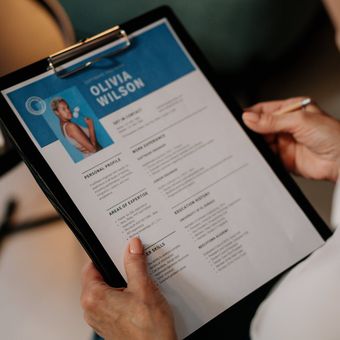
Apa itu CV?
CV memberikan informasi ekstensif dan detail tentang latar belakang profesional Anda dan tentang kredensial Anda.
Kredensial ini harus selalu mencakup pendidikan Anda, gelar yang diperoleh, pelatihan profesional, dan sertifikasi khusus industri.
Tergantung pada bidang pekerjaan, tingkat pekerjaan dan pengalaman bertahun-tahun, CV mungkin juga mencakup bagian tentang publikasi Anda, penghargaan, beasiswa, keanggotaan dan asosiasi profesional, presentasi konferensi, proyek penelitian, lisensi dan paten, pengalaman mengajar, pekerjaan sukarela, dan afiliasi bisnis lainnya.
CV juga menyertakan informasi dasar seperti informasi kontak, keterampilan dan pengalaman kerja.
Baca juga: 5 Hal di CV yang Bikin Kandidat Tampak Lemah di Mata HRD, Apa Saja?
Apa itu resume?
Resume adalah dokumen yang dimaksudkan untuk mengomunikasikan informasi tentang pengalaman profesional Anda kepada HRD perusahaan.
Akan tetapi, dibandingkan dengan CV, resume biasanya lebih pendek rata-rata satu hingga dua halaman, sedangkan CV bisa jadi cukup panjang karena memuat lebih banyak rincian tentang publikasi, penghargaan, dan pencapaian lainnya.
Sebagian besar resume menyoroti…
Tag cv cv adalah perbedaan cv dan resume resume adalah apa perbedaan antara cv dan resume.

Survei Ungkap 70 Persen Karyawan Bohong di CV, tentang Apa Saja?

Informasi tentang Pendidikan yang Harus Ditulis di CV, Jangan Salah

Lamar Kerja Lebih Baik Pakai CV Bahasa Inggris atau Indonesia?

Lakukan Ini Setelah Melamar Pekerjaan, Agar Resume Kamu Bisa Dilirik Perusahaan

Apa Itu Resume: Pengertian, Format, dan Contoh Resume Lamaran Kerja

TTS Eps 137: Yuk Lebaran
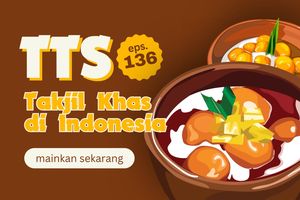
TTS Eps 136: Takjil Khas di Indonesia

TTS Eps 135: Serba Serbi Ramadhan
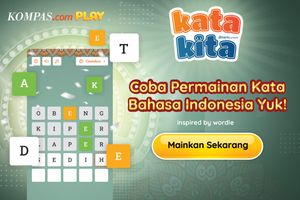
Games Permainan Kata Bahasa Indonesia
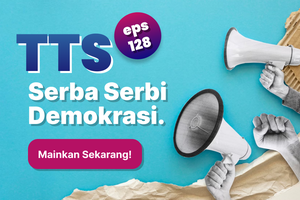
TTS - Serba serbi Demokrasi
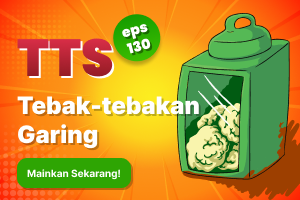
TTS Eps 130 - Tebak-tebakan Garing
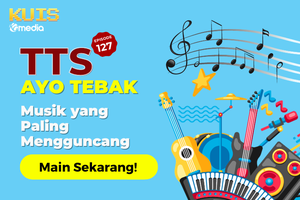
TTS - Musik Yang Paling Mengguncang
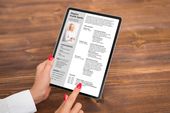
Terkini Lainnya

Kemendag akan Cabut Izin Usaha hingga Pidanakan Pelaku Usaha yang Curang Kurangi Isi Gas Elpiji

Pengendalian Inflasi

Mengenal Hak dan Kewajiban Konsumen di Sektor Jasa Keuangan

Baznas: Zakat 2023 Telah Mengentaskan Kemiskinan 574.903 Jiwa

Menaker Ida: Penggunaan TKA Harus Mendorong Pertumbuhan Ekonomi

Kemenperin Sebut Industri Tekstil Khawatir Serbuan Barang Impor, Ini Sebabnya

Bos Bulog Sebut Permintaan Beras SPHP Stabil meski Harga Naik

Daftar 12 BPR yang Dicabut Izinnya Sepanjang 2024

Perkuat Ketahanan Pangan Nasional, Kementan Lakuan Tanam Padi Gogo di Maja Banten

Pertamina Akan Perketat Pengawasan Penjualan Elpiji 3 Kilogram

Perjalanan Bisnis Avoskin, "Skincare" Lokal yang Terinspirasi dari Alpukat

Uang Beredar di Indonesia Hampir Tembus Rp 9.000 Triliun

Mana Lebih Untung, Beli Barang "Cash" atau Pakai Kartu Kredit?

Gandeng NavaPark BSD, Bank Mandiri Tawarkan KPR Hijau untuk Para Nasabah

Simak Kurs Rupiah 27 Mei 2024 di BRI hingga CIMB Niaga
Bos bpjs kesehatan jelaskan penyebab ikang fawzi antre layanan hingga 6 jam, ihsg diperkirakan sentuh "all time high" hari ini, berikut rekomendasi sahamnya, penjelasan lengkap bpjs kesehatan soal ikang fawzi antre layanan berjam-jam, naik, ini kupon st009, st010, st011, dan swr004 periode mei-agustus, ajinomoto indonesia buka lowongan kerja untuk lulusan s1, ini syaratnya, now trending.

Jadi Saksi TPPU SYL, Bos Maktour: Saya Pelayan Allah, Wajib Layani Siapa Pun yang Datang

Indeks Ketimpangan Gender Indonesia Konsisten Turun dalam 5 Tahun

Jaksa Agung dan Kapolri Duduk Semobil di Tengah Isu Jampidsus Dikuntit Densus

Jokowi Panggil Nadiem Makarim ke Istana, Bahas UKT Mahal

Tanggapi Keluhan Ikang Fawzi soal Layanan, Dirut BPJS: Jangan Digeneralisir, Saat Itu Lagi Perbaikan

Pembangunan Gereja Tertinggi di Dunia Hampir Rampung Setelah 144 Tahun

Jampidsus Dilaporkan ke KPK atas Dugaan Korupsi Lelang Barang Rampasan Negara

Sindir Kementerian yang Punya 5.000 Aplikasi, Jokowi: Ruwet, Perlu Kita Setop
Mungkin anda melewatkan ini.

Cara Mengetahui Faskes BPJS Kita Dimana lewat HP

Cara Ganti PIN ATM BCA, Mudah dan Praktis

Catat, Ini Rincian Batas Minimal Nilai UTBK untuk Daftar PKN STAN 2024

Pemerintah Bayar Kompensasi Listrik ke PLN Rp 17,8 Triliun

Lowongan Kerja Adaro Energy untuk Lulusan S1, Simak Persyaratannya
- Entertainment
- Pesona Indonesia
- Artikel Terpopuler
- Artikel Terkini
- Topik Pilihan
- Artikel Headline
- Harian KOMPAS
- Kompasiana.com
- Pasangiklan.com
- Gramedia.com
- Gramedia Digital
- Gridoto.com
- Bolasport.com
- Kontan.co.id
- Kabar Palmerah
- Ketentuan Penggunaan
- Kebijakan Data Pribadi
- Pedoman Media Siber
Copyright 2008 - 2023 PT. Kompas Cyber Media (Kompas Gramedia Digital Group). All Rights Reserved.
- CBSSports.com
- Fanatics Sportsbook
- CBS Sports Home
- Triple Crown
- Champions League
- Motor Sports
- High School
Football Pick'em
College Pick'em
Fantasy baseball, fantasy football, fantasy basketball, fantasy hockey, franchise games, 24/7 sports news network.
- CBS Sports Golazo Network
- PGA Tour on CBS
- UEFA Champions League
- UEFA Europa League
- Italian Serie A
- Watch CBS Sports Network
- TV Shows & Listings
The Early Edge
A Daily SportsLine Betting Podcast
With the First Pick
NFL Draft recap
- Podcasts Home
- The First Cut Golf
- Beyond the Arc
- We Need to Talk Now
- Eye On College Basketball
- NFL Pick Six
- Cover 3 College Football
- Fantasy Football Today
- My Teams Organize / See All Teams Help Account Settings Log Out
Ryan Garcia's B-sample comes back positive for banned substance as legal team denies intentional use
Garcia's big win over devin haney earlier this month could be in jeopardy.
Ryan Garcia shocked the boxing world on April 20 when he dropped Devin Haney three times en route to a majority decision victory. There was already an asterisk next to that victory after Garcia badly missed weight ahead of the bout, but things have continued to get worse for him after a second positive drug test.
On Thursday, the lab results for Garcia's B-sample came back with an adverse finding for the banned substance ostarine, according to multiple reports. This comes after Garcia reportedly failed a VADA drug test administered ahead of the fight. VADA tested Garcia the day before and the day after the Haney fight.
Garcia reacted to the news by writing, "I F---ING LOVE STEROID" in a since-deleted social media post. He followed it up with a toned-down post reading, "No babe."
In a statement to CBS Sports on Thursday, Garcia's legal team insisted that he has never intentionally used a banned substance.
"Ryan Garcia is committed to clean and fair competition and has never intentionally used any banned substance," Garcia's legal team wrote. "Soon after being notified of his positive test, Ryan voluntarily had his hair collected and shipped to Dr. Pascal Kintz, the foremost expert in toxicology and hair-sample analysis. The results of Ryan's hair sample came back negative. This is consistent with contamination and demonstrably proves that Ryan had not ingested Ostarine over a period of time — the only way he would have had any advantage whatsoever in the ring. "Ryan has voluntarily submitted to tests throughout his career, which have always shown negative results. He also tested negative multiple times leading up to the fight against Haney. All of these factors, combined with his ultra-low levels from samples taken on April 19th and 20th (in the billionth of a gram range), point to Ryan being a victim of supplement contamination and never receiving any performance-enhancing benefit from the microscopic amounts in his system. We are certain that one of the natural supplements Ryan was using in the lead-up to the fight will prove to be contaminated and are in the process of testing the supplements to determine the exact source."
Veteran boxing reporter Dan Rafael was the report Garcia's failed test on May 1 for ostarine. Rafael noted that Garcia tested positive on April 19 -- the day before the fight -- and on April 20 during his post-fight evaluation. ESPN then reported that they had obtained a VADA letter confirming the situation.
After a social media post featuring three crying emojis and "lol," Garcia briefly went live on X .
"You guys can see fake news," Garcia said earlier this month. "Fake f---ing news. Don't believe these f---ers. I never f---ing took a steroid in my f---ing life. I don't even know how that shit, it's the weirdest shit ever. "Supposedly they had it already, but they release it after I win? It makes no sense. I tested the day of the fight, nothing. ... Somebody paying somebody."
No babe — RYAN GARCIA (@RyanGarcia) May 23, 2024
Garcia had reportedly been cleared previously of a separate potential positive drug test for the 19-Norandrosterone metabolite, which derives from the banned substance nandrolone. The two positive ostarine tests are likely enough to impact his career.
Potential punishments for the failed tests could include a suspension, fines or having the fight result overturned to a no contest. Haney's team had previously filed a letter with the New York State Athletic Commission requesting that Garcia be disqualified, amending the result of their fight to a DQ win for Haney, according to Boxing Scene . More likely, the bout will be ruled a no-contest.
Garcia spent the build to the fight engaging in bizarre behavior which included ranting on social media about various conspiracy theories, claiming to be in possession of proof of aliens and claiming to be drinking alcohol regularly, which he admitted after the fight.
After the win, Garcia claimed this was all part of an elaborate plan to "troll" boxing fans, media and Haney and his team. Were that the case, the plan appeared to work perfectly as Garcia pulled off the biggest win of his career. With the test samples coming back positive, however, the result of the fight may be overturned to a no contest.
Of course, Garcia missing weight by more than 3 pounds meant that Garcia was ineligible to win Haney's WBC junior welterweight championship. The fight was originally planned as Garcia's first shot at a world championship, as well as an opportunity to prove he could hang with the sport's elite after getting dropped twice and stopped by Gervonta "Tank" Davis in 2023.
Our Latest Boxing Stories
How Usyk built a resume similar to Holyfield
Brent brookhouse • 5 min read.
Updating boxing fight schedule for 2024
Brent brookhouse • 2 min read.
P4P Rankings: Usyk takes over top spot
Brian campbell • 5 min read.
Five biggest takeaways from Fury vs. Usyk
Brian campbell • 7 min read.
Fury vs. Usyk results, card, guide
Usyk hospitalized with broken jaw after Fury win
Shakiel mahjouri • 1 min read, share video.

Garcia's B-sample tests positive for banned substance
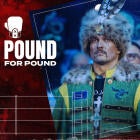
Chavez Jr. vs. Till set for Paul-Tyson undercard

Rumors: Alvarez gets unexpected mandatory

Jake Paul offering $2 million tickets to Tyson fight

Luka and Kyrie too much for Ant and an absent KAT

Braves' Acuña out for rest of season

Ex-UK guard Wagner heads to Arkansas

Newgarden wins Indy 500 back-to-back

IMAGES
VIDEO
COMMENTS
Differences between a resume and a CV. Among the key differences between a resume and a curriculum vitae, or CV, include the document's length, its contents and purpose. You should take note of which region of the world you're applying in, plus your career path, when deciding which is more appropriate to use. Most notably, in the United ...
The differences are: (1) A resume is one page (max. two) whereas the CV can be longer, (2) A resume is used for job hunting in all industries, the CV is used for jobs and admissions in Academia, (3) The resume is tailored to the specific job you are applying to, whereas the CV is a comprehensive overview. In the EU, both terms mean the same thing.
A CV is longer—it might be two or three pages (in fact, there's no page limit), depending on your experience, while a resume is typically one page long. Layout —a CV is an in-depth description of your academic and professional experience, while a resume is a brief document highlighting your professional experience.
Both words refer to the document you provide to employers outlining your work history and skills. The difference is that Americans use the word "resume," while people in most other countries use the word "CV.". However, when used in the United States, a "CV" also refers to an academic CV - a lengthy document used to apply for ...
Differences include: Resumes are the primary document for job applications, whereas CVs are specifically for academic, legal, research and scientific roles. Resumes are shorter, one page per every ten years worked. CVs contain more sections and details about your education, so they're longer.
Resume format. The biggest difference between CV and resume formatting is that CVs will be multiple pages long and resumes will be one page unless you have 10 or more years of relevant work experience. Effective resumes are designed to grab the attention of employers. Take some time to explore and create different templates.
In the U.S., a CV is different from a resume. Distinctions include: A resume vs CV is a brief, one-page document with a few essential sections, while a CV is a lengthy document that includes everything from a job applicant's career. A CV's format depends on the job and the job seeker's background, while a resume is limited to a few ...
A resume is brief and targeted document you submit it for non-academic jobs. In the UK, Ireland, the rest of Europe, and New Zealand, a CV is basically the same as the American resume: a short outline of your work history and skills. The term "resume" is not used.
Long answer: The CV's static in that it's not a document needing to be tailored for different positions in the way that a resume is. Rather, according to UNC Writing Center, the CV's a "fairly detailed overview of your life's accomplishments, especially those most relevant to the realm of academia," hence the variance in length; an ...
In most cases, the words "resume" and "CV" are synonymous — simply different terms for the exact same thing. CV means resume and resume means CV. As stated above, "Resume" is the term commonly used in the U.S. and Canada, while "curriculum vitae" or "CV" is the term used in most of the rest of the world. If you are ...
2. While the CV aims to show your professional experience, it does it with much more information and is much longer than the resume. On your CV, you have the freedom, and in fact are encouraged to, provide more details about education, work, values. It's very common that the CV is a few pages long.
CV vs. Resume Examples. Below is an example of a graphic designer's comprehensive CV. The graphic designer's CV is two pages long and features standard information expected in a typical resume. It also includes the applicant's past clients, projects, awards, certifications, and volunteer experience. ...
While both a resume and a curriculum vitae (CV) are used in job applications, they are not always interchangeable. The primary differences are length, what is included, and what each is used for. For example, CVs generally run longer than a resume and are more often used to highlight academic and research credentials.
Purpose. A CV is used in academic fields and for scientific/research purposes. A resume is used to find a job in just about every other field. 3. Details. In a CV, you provide an in-depth overview of your academic and professional career. In a resume, you provide brief summaries. Bullet points are often used.
This handout explains what a curriculum vitae (CV) is, how it differs from a resume, and how you can decide which one to use. It also includes a list of campus resources, helpful online tips, and recommended reference books. (Please note that this handout covers American usage of the terms "CV" and "resume."
Sections of a resume. A typical resume contains the following sections: 1. Contact information. Just like in a CV, provide your name, phone number, email address, and physical address (though this may be optional depending on location). 2. Objective or summary.
In brief: a CV is a detailed list of a person's career, academic achievements, and personal information, while resumés tend to be much shorter, providing a quick summary of a person's skills, experiences, and qualifications. Of course, the differences go a little deeper than that and are difficult to sum up in a single paragraph. But that's ...
The primary differences between CVs and resumes are: Emphasis. Length. Information included, such as your educational history, career biography and professional qualifications. Get professional support in getting your CV or resume right for your job applications. Register to speak to our career coaches now!
CV vs resume: 3 main differences. Here are the 3 key CV vs resume differences: 1. CVs are longer. CVs are longer than resumes because UK employers expect to learn all about your professional and educational background, like unrelated jobs and your GCSE/A-Level (or Scottish Highers/Advanced) grades. They also want to get a taste of your ...
• CV is Latin for Curriculum Vitae (course of life). In the U.S., a C.V is an exhaustive academic summary used for applications for roles in academia, scientific research and medical fields. In Europe, Ireland and New Zealand, the term CV is used to mean the same as a "resume" in the U.S. • Resume is derived from the French word résumé,
Resume - Highlights your relevant skills, work experience, and achievements. It is more focused on demonstrating your qualifications for a specific job or industry. Purpose. CV - Preferred in educational institutions, creative positions, and grant-giving bodies.
CVs are often longer than resumes. With our CV maker, you can create a CV in the same amount of time. Monday to Friday, 8AM - 12AM (Midnight) and Saturdays and Sundays, 10AM ... The best way to learn is by taking inspiration from resume examples written by other candidates in your industry. 16 categories +442 free templates.
Example: "Built rapport with a diverse clientele, resulting in a 15% increase in client retention rate." Tips for using personal skills on your resume to attract recruiters. Follow these tips to use your personal skills to stand out to recruiters and hiring managers:
Most resume summaries are roughly three sentences long, and include the following information: Sentence #1: Your biggest selling points as a candidate, including how many years of relevant work experience you have. Sentence #2: One or more specific accomplishments or skills from your career to show employers what they can expect from you if hired for their open position.
4. List key skills and proficiencies. Include a "key skills" section to help further focus your resume on your relevant background. For many high schoolers (especially those with limited work experience), this section should include "soft skills" like problem-solving and collaboration.
Transferable skills: Examples. Not sure what skills to showcase? Here are 10 examples of transferable skills to include on your resume—feel free to incorporate them into your cover letter or job application as well. Just remember, while these are relevant and common skills, you shouldn't feel restricted by them.
JAKARTA, KOMPAS.com - Curriculum vitae atau CV adalah komponen kunci dalam proses mencari kerja. Namun demikian, tidak sedikit kandidat juga mengirimkan resume kepada HRD perusahaan. Kenyataannya adalah bahwa perusahaan, bidang, atau lokasi tertentu mungkin lebih memilih atau memerlukan CV untuk menunjukkan latar belakang profesional Anda, namun tidak sedikit juga yang memilih resume ...
All of these factors, combined with his ultra-low levels from samples taken on April 19th and 20th (in the billionth of a gram range), point to Ryan being a victim of supplement contamination and ...